Bulletin – August 2005 Statement on Monetary Policy
Download the complete Statement 930KB
The global expansion is continuing to provide a favourable backdrop for the Australian economy. In the United States growth remains well entrenched, with another solid outcome being posted in the June quarter. In China the rapid expansion seen over recent years is showing no sign of slackening. The Japanese economy, although not generally a significant contributor to world growth in recent years, now seems to be performing better after some disappointing results in 2004. Growth in the rest of east Asia appears reasonably solid this year, while the main weak spot for the world economy remains the euro area. Overall, most official and private-sector forecasts are that world growth will be above average in 2005 and 2006, though below last year's pace. Higher oil prices in recent months have not generally been viewed as endangering the global expansion, but are seen mainly as a sign of continuing demand pressures.
The main news in world financial markets recently was the announcement of new exchange rate arrangements for China, involving an immediate appreciation of 2 per cent against the US dollar and the move to a managed peg. While the initial appreciation was small, the new arrangements provide for greater flexibility of the exchange rate over time. This should be of benefit to China in the medium term, as it will help the authorities to gain greater control over their domestic monetary conditions, and hence to contain inflationary pressures in goods and asset markets more effectively. Most other Asian currencies rose in parallel with the Chinese currency. The Australian dollar was little affected, and remains in the same broad range it has been in since late 2004. Aside from the Chinese announcement, there were few major developments in global markets in recent months. Market expectations of monetary policy tightening in the US have increased a little, with the fed funds rate now expected to reach 4 per cent by the end of the year. Global equity markets have remained strong, underpinned by strong company profit results in all the major countries.
In Australia, recent economic data continue to suggest that domestic demand is growing more slowly this year than it was in 2004. Households now seem to have entered a phase in which they are consolidating their balance sheets, borrowing less and increasing their spending less quickly than they were a year or two ago. Combined with the mild downturn now underway in the housing construction cycle, the adjustment in consumer spending is helping to put overall growth in domestic demand onto a more sustainable trend, after the period of rapid growth in demand that was experienced particularly in 2002 and 2003.
This adjustment in household balance sheets comes at a time when other factors are continuing to support spending and activity. Employment has been expanding strongly, which is contributing to growth in household incomes, as are the tax cuts that came into effect on 1 July. The boost to national income from rising export prices is continuing to support growth of the economy overall, and the outlook for the farm sector has improved over the past couple of months following widespread rains in the eastern states. It now appears likely that crop production this year will be around average, compared with the well-below-average outcomes that seemed likely three months ago.
Recent indicators suggest that conditions in the Australian business sector have remained favourable. The broadest surveys of non-farm businesses are reporting above-average conditions, though they are not as strong as in 2004; capacity utilisation in the June quarter is reported to have remained close to its highest level in more than a decade. Given high levels of capacity utilisation and profits, and the sound balance sheets of the business sector, businesses seem to be in a good position to continue expanding their investment spending. Forward indicators are generally pointing to further growth in aggregate investment, with the prospects for engineering construction activity looking particularly strong. The good condition of the business sector has been reflected in the Australian share market, which has risen strongly this year.
There are also signs that the economy is benefiting from an improving international trade performance. Preliminary estimates suggest that growth in import volumes has eased in the first half of this year, while export growth has picked up a little. With export prices up strongly, this has meant a narrowing of the trade deficit, which should also be reflected in lower current account deficits in coming quarters.
Overall, while the growth of domestic demand in Australia has eased this year, the economy continues to be characterised by a solid pace of growth in non-farm output and by strong labour market conditions. There are, as always, some regional disparities in economic performance. Relative to the national economy, the larger states (particularly New South Wales) have experienced a more pronounced slowing in demand and activity over the past year, with the other states, particularly resource-rich Western Australia and Queensland, performing more strongly than the national average.
Consumer price inflation remained stable at around 2½ per cent over the year to the June quarter, in both headline and underlying terms. Data on producer prices in the quarter suggest that upstream prices are no longer accelerating as they were during the second half of 2004. The recent increases in international oil prices have not yet been fully reflected in the quarterly prices data, and will add to consumer and producer prices in the September quarter. As a result, the annual CPI inflation rate is likely to move somewhat higher than underlying measures in the short term.
The outcome for underlying inflation in the June quarter was consistent with the inflation outlook described in the May Statement. The Bank's assessment is that underlying inflation is likely to increase gradually from its current level, partly as a result of the fading of exchange rate effects which have been holding the inflation rate down during the past couple of years. Nonetheless, the slowing in domestic demand that has now occurred should help to contain pressures in the medium term. Underlying inflation is forecast to rise to a peak of around 3 per cent by the second half of next year. A possible source of upside risk to this forecast is the tightness of the labour market, which might generate faster growth in labour costs than is currently assumed. On the other hand, the easing in domestic demand could have a larger-than-expected dampening influence, and the current below-trend pace of GDP growth should contribute to some easing in labour market pressures over time. Currently the risks to the forecasts are judged to be evenly balanced, whereas earlier in the year they had appeared to be weighted to the upside.
Financial conditions do not appear to be inhibiting the growth of the economy at present. The current level of the cash rate is close to its historical average, and lending rates are still somewhat below average as a result of the increased availability of discounted loans. While overall credit growth has eased from the pace of a year ago, it has only fallen to an annual rate of around 12 per cent. There has, however, been quite a pronounced change in the composition of credit growth. The amount of credit flowing into housing has slowed substantially over the past eighteen months, and this has been associated with a cooling in the housing market. In contrast, business credit has been strengthening during this period. Unlike households, businesses had previously been quite restrained in their use of credit, and they appear to have considerable scope to borrow more to finance further growth in investment.
In summary, the economic situation under consideration by the Board at its recent meetings has been characterised by a number of favourable developments. Domestic demand has slowed from its previous rapid pace and is now on a more sustainable trend. Households appear to have entered a period of balance-sheet consolidation. This adjustment is coming at a time when national income is being boosted by the increase in Australia's terms of trade, while the substantial downside risks to the farm sector have eased following recent rains. Overall, the Australian economy is operating at a high level of capacity utilisation, and recent economic data have appeared consistent with an economy growing at a reasonable though not excessive pace. Against this background the Board took the view at its June and July meetings that the medium-term inflation risks were not as strong as they had been earlier in the year. As a result, it decided to hold the cash rate unchanged pending any further information on prices that might prompt a reassessment of the inflation outlook.
In the event, June quarter inflation data available for the August meeting indicated that consumer price inflation had remained stable in both headline and underlying terms, while upstream price pressures appeared to have eased. While the Board's judgment remains that underlying inflation is likely to increase over the next year or so, the extent of the increase should be quite limited, unless there is a significant re-acceleration in domestic demand. The latter seems unlikely, although of course it cannot be ruled out entirely. Given this combination of circumstances, the Board decided in August to hold the cash rate unchanged. The Board will continue to monitor developments and make such adjustments as may be required to promote sustainable growth of the economy with low inflation.
International Economic Developments
Introduction
The global economy has continued to expand at a solid pace. Growth remained strong in the US and China over the first half of 2005, and the Japanese economy has recently picked up following its disappointing performance through much of 2004. In contrast, growth in the rest of east Asia eased in the first half of the year, in line with the slowdown in the growth rate of the global ITC sector, and conditions in the euro area have weakened further. In the face of strong world demand, oil prices have continued to rise, recently trading at over US$60 per barrel, but this has not to date had a major moderating impact on growth expectations. The latest Consensus forecasts are for world growth of 4¼ per cent in both 2005 and 2006, a rate somewhat below the rapid pace set in 2004 but well above the historical average (Table 1). Solid growth in the US and China underlies this outlook, with only modest contributions to growth forecast from the euro area and Japan. Growth in other parts of the world, including Latin America, emerging Europe, India and the Middle East, has also contributed to the strong global outlook.
| 2003 | 2004 | 2005 | 2006 | |
|---|---|---|---|---|
| Consensus forecasts (July 2005) |
||||
| United States | 3.0 | 4.4 | 3.6 | 3.2 |
| Euro area | 0.7 | 2.0 | 1.3 | 1.7 |
| Japan | 1.4 | 2.7 | 1.5 | 1.5 |
| China | 9.5 | 9.5 | 8.9 | 8.0 |
| Other east Asia(b) | 3.7 | 5.8 | 4.3 | 4.8 |
| Latin America | 2.0 | 5.8 | 4.0 | 3.7 |
| Emerging Europe | 6.1 | 7.4 | 5.4 | 5.3 |
| Australia's trading partners(c) | 3.4 | 5.0 | 3.7 | 3.8 |
| World | 4.0 | 5.1 | 4.3 | 4.2 |
|
(a) Aggregates weighted by GDP at PPP exchange rates unless otherwise specified Sources: CEIC; Consensus Economics; IMF; RBA; Thomson Financial |
||||
United States
The US economy continues to grow at a solid rate. Real GDP increased by 0.8 per cent in the June quarter, to be 3.6 per cent higher over the year (Graph 1). The quarterly result reflected robust contributions to growth from domestic final demand and net exports, partly offset by a rundown in inventories.
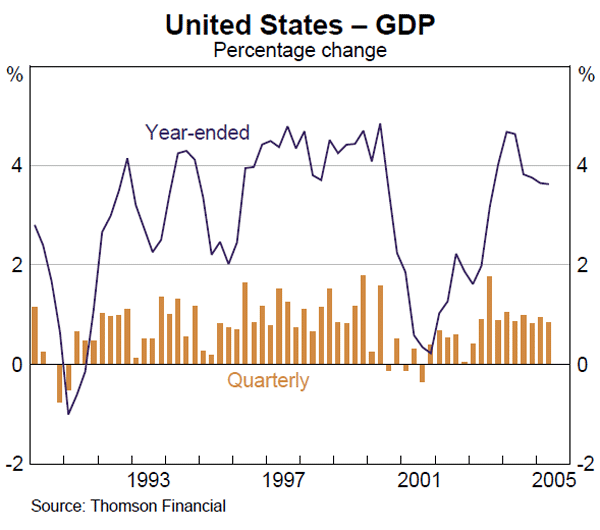
Consumption grew by 0.8 per cent in the June quarter and by 3.9 per cent over the year, supported by firm labour market conditions, further increases in household wealth and a recovery in consumer confidence. Labour market developments have continued to be favourable: non-farm payrolls increased by 1.6 per cent over the year to June (Graph 2); the unemployment rate fell to 5.0 per cent in June, the lowest rate since September 2001; and initial jobless claims have settled at around 320,000, which has traditionally been associated with monthly payrolls gains of more than 200,000.
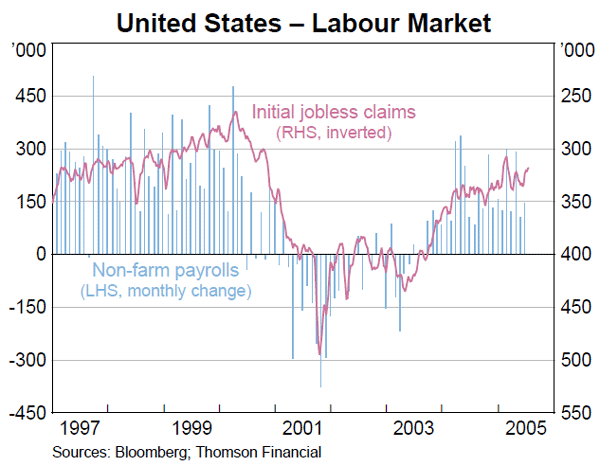
Low interest rates and large gains in house prices have continued to underpin strength in house building. Dwelling investment grew by 5.8 per cent over the year to the June quarter and is at an historically high share of GDP (Graph 3). House prices advanced by 12.5 per cent over the year to the March quarter. In some regions, such as Florida, California and Nevada, house prices have grown by more than 20 per cent over the past year, which has elicited concerns in the US about potential overvaluation of house prices.
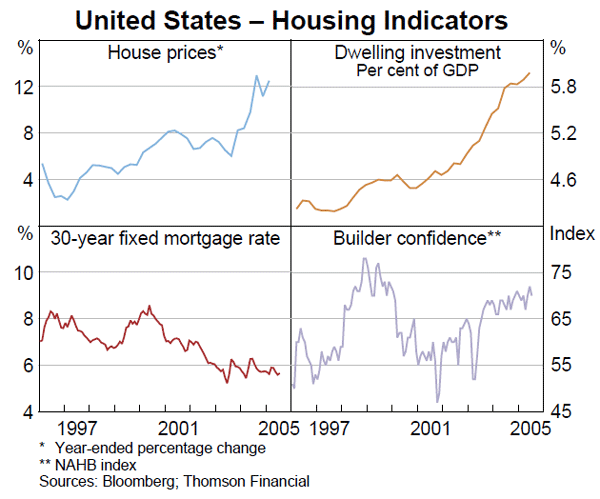
Indicators from the business sector are favourable. In the June quarter, investment increased by 2.2 per cent to be 9.2 per cent higher over the year, as high levels of internal funding, combined with accommodative external financing conditions, have continued to underpin the investment upswing. Core capital goods orders, which are a forward indicator of equipment investment, were up by 13 per cent over the year to June. Corporate profits increased by 12.3 per cent over the year to the March quarter and, as a share of GDP, are around the peak reached in 1997, which was the highest level since the late 1960s. Measures of business sentiment remain at above-average levels.
The US current account deficit reached 6.4 per cent of GDP in the March quarter. Net exports contributed to growth for the first time in almost two years in the June quarter, as export growth picked up and imports fell. Over the year, export volumes grew by 8 per cent, outpacing growth of 5 per cent in imports.
Inflation has remained contained, despite a sharp 4.3 per cent increase in unit labour costs over the year to the March quarter and the persistence of high oil prices. Excluding the volatile food and energy components, the CPI increased by 2.0 per cent over the year to June, and the chain price index for personal consumption expenditure increased by 1.9 per cent (Graph 4). The Federal Reserve has continued to remove its policy accommodation, lifting the federal funds rate by a further 25 basis points to 3.25 per cent at its June meeting and foreshadowing future increases.
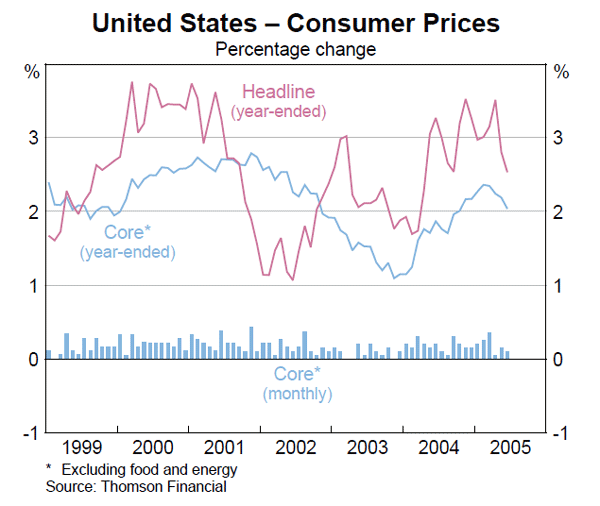
Asia-Pacific
Japan
The Japanese economy appears to be showing greater strength after faltering during 2004. Real GDP is estimated to have grown by 1.2 per cent in the March quarter, to be 0.9 per cent higher over the year (Graph 5). The March quarter's strong result may overstate the true strength of the economy, just as the previous three quarters' GDP figures may have understated it. However, improvements in the labour market, the healthier state of corporate balance sheets and the higher levels of consumer and business sentiment suggest that the present expansion in activity may prove to be more durable than the short-lived upswings seen in earlier years.
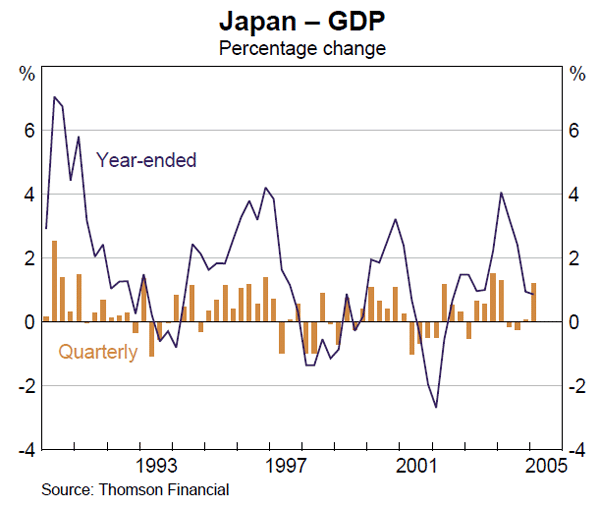
The outlook for consumer spending is positive. Consumption increased by 1.1 per cent in the March quarter and consumer sentiment is at a high level, buoyed by improving labour market conditions. Employment continues to expand at a moderate pace; payrolls grew by 0.6 per cent over the year to June, and the unemployment rate was 4.2 per cent, its lowest level in almost seven years. Employment growth of late has been concentrated in full-time positions for the first time in almost 10 years (Graph 6). Leading indicators of employment growth are positive, with measures of hiring intentions from business surveys above their long-run average levels.
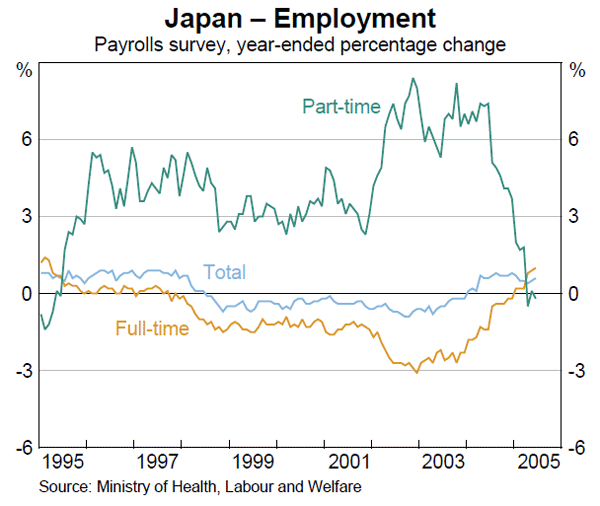
The slowdown in the global ITC sector has constrained the recovery of the corporate sector, although overall conditions are improving. ITC inventories are still at a high level and total merchandise export volumes increased by just 4 per cent over the year to June, down from almost 20 per cent a year earlier. Nevertheless, the fundamentals have strengthened: corporate profits after interest grew by 14 per cent over the year to the March quarter; firms have reduced excess labour and improved their balance sheets; and capacity appears to be stretched in the manufacturing sector. In addition, investment intentions in the June quarter Tankan survey were revised upwards substantially, and the manufacturing PMI and the Economy Watchers survey have also trended upwards since the start of the year.
Banking sector balance sheets are also looking healthier. The Financial Services Agency recently announced that the major banks met the government's targeted reduction in non-performing loans for the period to March 2005. Further, the pace of decline in underlying bank lending has slowed to only 0.3 per cent over the year to June, compared with almost 3 per cent in mid 2002.
Domestic corporate goods prices increased by 1.4 per cent over the year to June due to high oil and commodity prices. Nevertheless, there is still mild deflation in prices at the consumer level. The core CPI, which excludes fresh food prices, fell by 0.2 per cent over the year to June and would have declined further if energy products were also excluded. Another factor contributing to falling consumer prices in recent months has been a decline in electricity and telephone charges following deregulation.
China
The rapid expansion in the Chinese economy continued in the first half of 2005, with real GDP reported to have increased by 9½ per cent over the year to the June quarter. The shift in the mix of growth away from investment seems not to have continued; after slowing over the first half of 2004, growth in urban fixed investment has picked up to 29 per cent over the year to June, well above the official target for 2005 of 16 per cent. Retail sales grew by 13 per cent over the year to June.
Industrial production grew by 17 per cent over the year to June, compared with 14 per cent over 2004. Exports have continued to grow rapidly, to be 30 per cent higher over the year to June, while import growth remains sluggish by recent standards, at around 16 per cent over the same period (Graph 7). This has resulted in a widening trade surplus that is likely to result in a sizeable current account surplus in 2005.
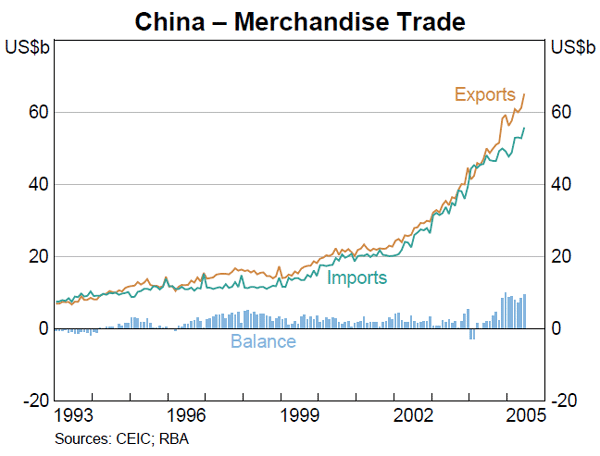
The growth rates of money and credit have remained relatively strong, at 16 and 13 per cent respectively over the year to June. Growth in consumer prices remains well contained at 1.6 per cent over the year to June; excluding food, consumer price inflation was 1.5 per cent. Price pressure remains more evident at the producer level, with producer price inflation at 5.2 per cent over the year to June. Growth in property prices, however, eased to 8 per cent over the year to the June quarter following official measures to curb speculative activity, and this easing has been most pronounced in the cities that experienced the most rapid growth in property prices, such as Shanghai. On 21 July, the renminbi was revalued by 2.1 per cent against the US dollar and its value will henceforth be managed with reference to an undisclosed basket of currencies (for further details see the ‘International and Foreign Exchange Markets’ chapter in this Statement).
Other Asia-Pacific
Growth in the rest of east Asia has continued to moderate somewhat, but remains generally firm. Real GDP for the region increased by 3.8 per cent over the year to the March quarter. Growth in Indonesia, Malaysia and the Philippines has been boosted by robust domestic demand and buoyant commodity markets, while in Hong Kong the economy is benefiting from increasing integration with China (Graph 8). Growth was slower in Singapore, Taiwan and Korea, reflecting ongoing inventory adjustments associated with the slowdown in growth of the global ITC sector (for further details see ‘Box A: Developments in the ITC Sector’). However, growth appears to have picked up in the June quarter in Singapore and Korea.

Export growth has slowed over the past year, but appears to have stabilised at an annual rate of just over 10 per cent. Exports in south-east Asia have been boosted by high commodity demand. In recent months, ITC exports from Asia have started to improve, recording growth of around 10 per cent in the three months to June. Industrial production has levelled out, after falling in early 2005, to be 2.0 per cent higher over the year to May.
Domestic demand growth has been firm across most of the region, with retail sales remaining buoyant, supported by improving labour markets, low interest rates and rising asset prices. Growth has been somewhat weaker in Thailand and Korea. Confidence in Thailand has been affected by several factors, including the tsunami, unrest in the south and a drought. The Thai government has recently undertaken expansionary policies focused on construction in the tsunami-affected areas and on infrastructure more broadly. Growth in Korea has been subdued, but the recovery of domestic demand is progressing, as the repair of household balance sheets appears to be nearing its end. Consumption increased for the fourth consecutive quarter in June, and employment grew by 1.9 per cent over the year to June.
High crude oil and other commodity prices continue to boost headline consumer prices in the region, although there is significant variation in inflation rates across countries. While annual inflation has been very low in Singapore and Hong Kong, price increases have been larger in Thailand and Malaysia, boosted in both cases by reductions in fuel subsidies. Inflationary pressures prompted the Bank of Thailand to increase its policy rate by 25 basis points in both June and July to a level of 2.75 per cent, and Taiwan's central bank also continued to remove its monetary policy accommodation. Inflation in Indonesia has remained above 7 per cent and was 7.8 per cent over the year to July. Bank Indonesia has been tightening monetary policy, and in early July adopted a formal inflation-targeting policy framework. On 21 July, Malaysia moved to a managed float of the ringgit against a basket of currencies.
In India, real GDP increased by 7.1 per cent over the year to the March quarter. The manufacturing and services sectors made the strongest contributions to growth, while agricultural output increased only modestly. Growth in industrial production was 10.8 per cent over the year to May, having recovered from a sharp dip earlier in the year that was associated with coal shortages. Export growth has eased significantly, to 19 per cent over the year to June compared with over 40 per cent a year earlier, but imports have continued to grow strongly, rising by 30 per cent over the year to June. Wholesale price inflation has been moderating over the past year and was 4.1 per cent in June.
In New Zealand, economic growth has eased from the rapid pace recorded in early 2004. Real GDP increased by 0.6 per cent in the March quarter, to be 2.5 per cent higher over the year. Domestic final demand expanded by 2.0 per cent in the quarter, as residential construction bounced back after declining in the previous two quarters, and consumption and business investment growth remained firm. Net exports subtracted from growth in the quarter, as export volumes fell by 2½ per cent. The Reserve Bank of New Zealand has held the official cash rate at 6.75 per cent since March. CPI inflation was 0.9 per cent in the June quarter, leaving the year-ended rate unchanged at 2.8 per cent.
Europe
Economic conditions in the euro area have deteriorated, as domestic demand has failed to compensate for the weakening external impetus. Euro-wide GDP grew by 1.4 per cent over the year to the March quarter, and while quarterly growth picked up to 0.5 per cent, it was entirely attributable to a fall in imports, with no growth in domestic demand (Table 2). German GDP was estimated to have grown by 1.0 per cent in the March quarter, but this quarterly result may have been overstated by working-day adjustments. Growth slowed in France, and GDP contracted in Italy and the Netherlands. Of the major euro area economies, only Spain is growing steadily, with activity underpinned by strong house price gains and an investment boom.
| December quarter 2004 |
March quarter 2005 |
Year to March quarter 2005 |
||
|---|---|---|---|---|
| Euro area | 0.2 | 0.5 | 1.4 | |
| – Germany | −0.1 | 1.0 | 1.1 | |
| – France | 0.7 | 0.3 | 1.8 | |
| – Italy | −0.4 | −0.5 | −0.2 | |
| – Netherlands | 0.0 | −0.8 | 0.1 | |
| – Spain | 0.9 | 0.9 | 3.3 | |
| United Kingdom | 0.6 | 0.4 | 2.1 | |
|
Source: Thomson Financial |
||||
Recent indicators suggest euro area growth lost further momentum in the second quarter. The surge in industrial orders at the end of 2004 has now been largely unwound. After a temporary bounce in April, production fell by 0.3 per cent in May to be unchanged from its level a year earlier, and the manufacturing PMI was below the break-even 50 level during the June quarter. Year-ended export growth has moderated from more than 10 per cent in mid 2004 to 6 per cent in May, as exporters have faced an appreciating euro and rising input costs. Across the euro area, the decline in production and exports has depressed business confidence, which has dropped to below-average levels (Graph 9).
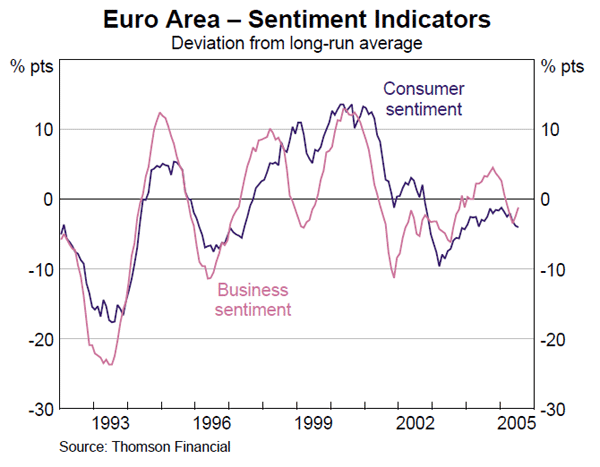
Indicators from the household sector remain subdued, weighed down by low confidence, uncertainty about the course of reforms and a sluggish labour market. Euro-wide consumption growth slowed in the March quarter, and consumption declined in Germany, with weak confidence and reductions to unemployment benefits offsetting the potential boost from income tax cuts. Recent retail sales data remained weak in Germany and Italy, and retail sales growth has eased in France. The euro-wide unemployment rate remained high, at 8.7 per cent in June.
While higher energy costs have lifted producer price inflation, the European Commission survey indicates that firms have not fully passed these input cost increases on to consumers. Year-ended consumer price inflation has fluctuated around the ECB's 2 per cent reference rate since the start of the year, and was 2.2 per cent in July, with underlying inflation lower at 1.4 per cent in June. The ECB has continued to hold the repo rate steady at 2 per cent.
The pace of growth of the UK economy has slowed, as the cooling housing market dampens consumer spending and external demand has eased. Preliminary data suggest GDP growth was 0.4 per cent in the June quarter and eased to 1.7 per cent over the year, compared with 3.7 per cent a year earlier. House prices in the UK remained broadly unchanged during the first half of 2005, compared with year-ended growth of around 20 per cent a year ago, and the value of housing loan approvals in June was 15 per cent below its late 2003 peak (Graph 10). While consumer confidence has eased in recent months, it remains above average levels. This may reflect the strength of the labour market; the unemployment rate remains low and average earnings growth is still around trend at 4 per cent in year-ended terms.

Inflation remains well contained, with consumer price inflation at 2 per cent over the year to June and underlying inflation at 1.4 per cent over the same period. The Bank of England has held the repo rate at 4.75 per cent since August 2004.
Box A: Developments in the ITC Sector
Developments in the global information, technology & communication (ITC) goods sector are an important driver of activity, particularly in east Asia, which has become the global manufacturing base for ITC products. Demand for ITC goods surged during 2003 and early 2004, but has eased noticeably since then. The outlook for the sector has nonetheless improved in the past few months, and activity is expected to rebound sometime in the second half of this year.
The latest cyclical upturn in the ITC sector reached its peak around mid 2004, when growth in world semiconductor sales, a commonly used indicator of the current state of the ITC cycle, reached its highest rate since late 2000. The upswing was consistent with the pick-up in world economic activity, which has become increasingly correlated with the ITC cycle since the late 1990s (Graph A1). This increased correlation highlights the growing importance of ITC goods to both the business and household sectors.
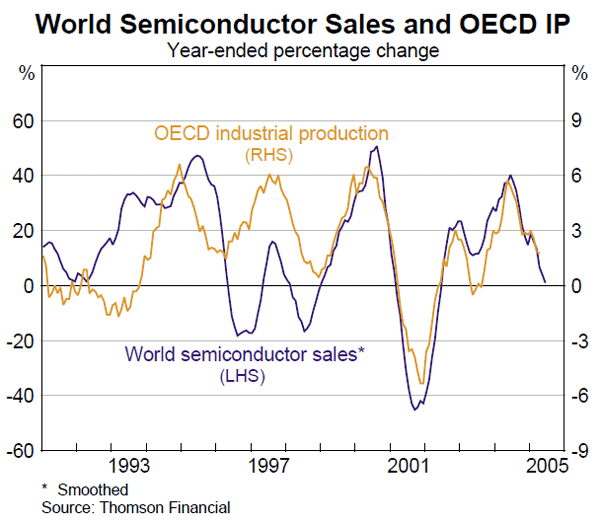
Semiconductor sales have been flat since mid 2004, such that the year-ended growth rate slowed from about 40 per cent to 1 per cent in June 2005. Most industry analysts expect that the slowdown will be short-lived, and milder than the 2001 downturn, with a recovery expected sometime in the second half of this year. This expectation partly reflects that inventories have not been built up to the extent seen in 2000–2001, and also that demand has been more balanced between households and businesses. More than half the semiconductors sold in 2004 were for consumer goods.
The positive outlook is also based on expectations that continued strong world growth will underpin demand, especially demand from the US where investment in ITC goods has been rising rapidly. In line with this, the Federal Reserve Bank of New York's Tech Pulse Index, which is a broad measure of the health of the US ITC industry, is growing at a fast pace. The US semiconductor equipment book-to-bill ratio, a closely watched indicator of future semiconductor production, has also risen sharply in recent months, although it is still below 1, implying that orders are falling short of current shipments (Graph A2). Investors also seem to have become more optimistic about the prospects for the ITC industry, with the Philadelphia Semiconductor Index of share prices and the broader NASDAQ Composite Index both at their highest levels in over a year.

Economic growth in east Asia is particularly sensitive to developments in the global ITC sector, because of the high share of ITC goods in its exports. ITC goods account for one-third of total merchandise exports from the region as a whole, and more than half of the exports from Malaysia and the Philippines. The ITC shares of China's and Korea's exports have risen significantly over the past five years to be more than 35 per cent in 2004; China is now the largest ITC exporter in the region. The softening in ITC demand has accordingly contributed noticeably to slower economic growth in the region since mid 2004, and production of ITC goods has remained subdued in recent months. While considerable progress has been made in reducing inventories, the adjustment may still have further to run. However, growth is expected to pick up as companies work off excess inventories, and there are already signs of recovery in the rebound in growth of ITC exports since late 2004 (Graph A3).
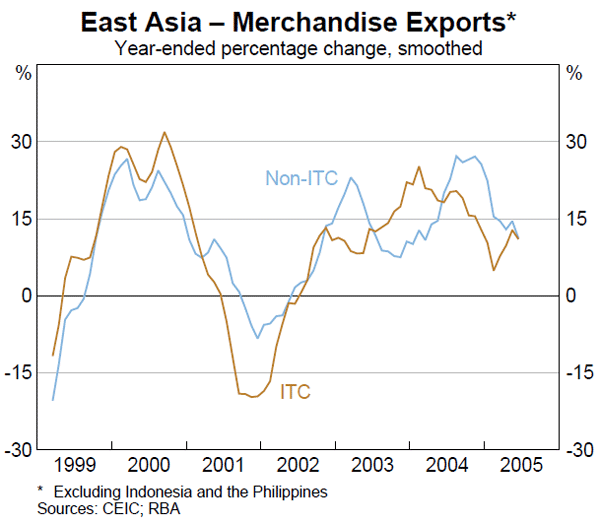
International and Foreign Exchange Markets
Exchange rates
Broadly speaking, global foreign exchange markets have been quiet over the past three months, apart from the activity around the announcement by Chinese authorities on 21 July of changes to their exchange rate regime. The renminbi will now be pegged to a basket of currencies, rather than solely to the US dollar. At the end of each day, the People's Bank of China (PBoC) now announces the exchange rate of the renminbi against a number of currencies in the basket for the following trading day. Daily fluctuations in the renminbi will then be contained to a narrow trading band, e.g. ±0.3 per cent against the US dollar. This exchange rate regime shares a number of similarities with that in place in Australia prior to the floating of the Australian dollar in December 1983.
At the time of the announcement, the renminbi was revalued by 2.1 per cent against the US dollar (Graph 11). Since then the reference rate to the US dollar has moved marginally both upward and downward on a daily basis. The non-deliverable forward market for the renminbi implies that the market is expecting a further 4½ per cent appreciation against the US dollar over the next year. However, recent statements from the PBoC have stressed that no further major movement in the exchange rate is in prospect.
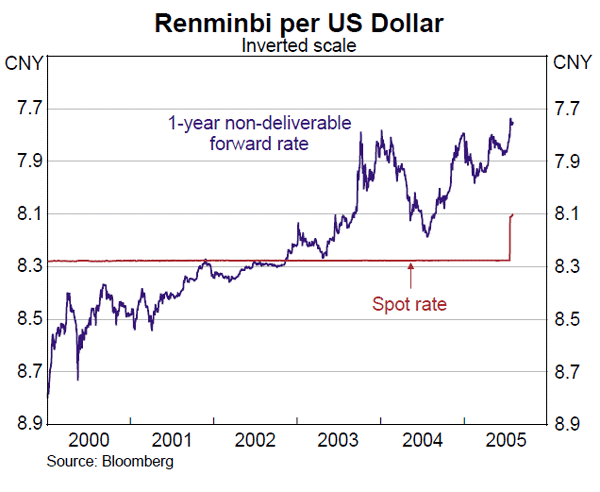
One hour after the Chinese announcement, Malaysia announced that it too was abandoning its peg to the US dollar which had been in place since the Asian crisis. It has moved to a managed float against a basket of currencies similar to the regime in place in Singapore. Prior to these developments, in late May the Hong Kong Monetary Authority (HKMA) introduced a trading band for the Hong Kong dollar of 7.75 to 7.85 per US dollar. This was intended to address concerns over trading in the Hong Kong dollar as a speculative vehicle for the renminbi. Previously, the HKMA imposed a strict limit of 7.80 on the extent to which the currency could depreciate, but had no explicit boundary on the extent of appreciation.
The Japanese yen, Korean won, Thai baht and Singaporean dollar all appreciated by around 2 per cent against the US dollar immediately following the announcement by the PBoC (Graph 12). The Malaysian ringgit appreciated by a smaller amount in the first few days of its new regime.
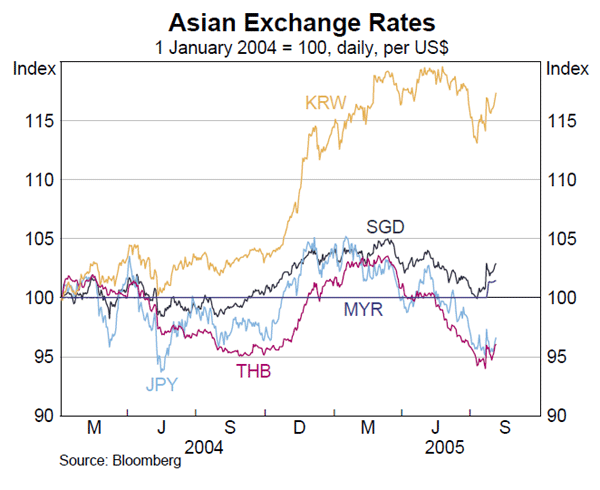
Prior to the Chinese developments, the US dollar continued the appreciation that had been occurring since the start of the year, reflecting the ongoing tightening of monetary policy in the US and the publication of strong data on the US economy (Graph 13). Despite some initial volatility around the time of the Chinese announcement, the US dollar has subsequently remained relatively stable. In trade-weighted terms it is around 2½ per cent higher so far this year.
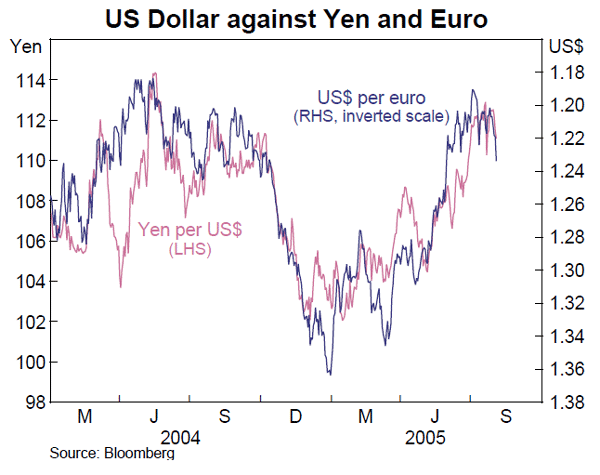
Developments in expectations about the future path of short-term interest rates have also had an important influence on foreign exchange markets in some countries over the past three months (Table 3). Reflecting heightened expectations of an easing in monetary policy (see below), the British pound has declined against the US dollar since early June. Similarly, the New Zealand dollar fell as expectations about further monetary policy tightening were scaled back. In contrast, the Canadian dollar appreciated noticeably, reflecting expectations of rate increases in the near term.
| Since US$ peak Jan 2002 |
2005 to date | Since last Statement |
||
|---|---|---|---|---|
| South Africa | −41.7 | 16.0 | 7.6 | |
| New Zealand | −37.7 | 4.9 | 6.6 | |
| Australia | −32.0 | 2.0 | 1.8 | |
| Euro area | −30.2 | 9.9 | 4.9 | |
| Sweden | −26.9 | 16.3 | 8.6 | |
| Canada | −24.1 | 1.1 | −2.6 | |
| Switzerland | −23.6 | 13.1 | 7.6 | |
| South Korea | −23.2 | −1.7 | 1.8 | |
| United Kingdom | −19.4 | 9.1 | 7.6 | |
| Japan | −17.0 | 8.9 | 6.8 | |
| India | −10.0 | −0.3 | 0.0 | |
| Singapore | −9.8 | 1.3 | 1.1 | |
| Taiwan | −9.0 | 0.4 | 2.3 | |
| Indonesia | −6.7 | 4.8 | 2.4 | |
| Thailand | −6.2 | 6.0 | 4.9 | |
| Brazil | −4.6 | −13.0 | −6.2 | |
| China | −2.1 | −2.1 | −2.1 | |
| Malaysia | −1.4 | −1.4 | −1.4 | |
| Hong Kong | −0.3 | −0.2 | −0.2 | |
| Philippines | 9.4 | −0.2 | 3.8 | |
| Mexico | 15.3 | −5.1 | −3.5 | |
| US broad TWI | −14.9 | 2.4 | 1.1 | |
|
Source: RBA |
||||
In Latin America, most currencies have appreciated against the US dollar, notwithstanding a temporary sharp fall in the Brazilian real following allegations of corruption against the government.
Australian dollar
On a trade-weighted basis, the Australian dollar has appreciated since the last Statement, as international investors have remained favourably disposed to the currency, largely because of the strong gains that are taking place in Australia's terms of trade. During the period the trade-weighted index reached its highest point since early 2004 and is towards the top end of its post-float range (Graph 14).
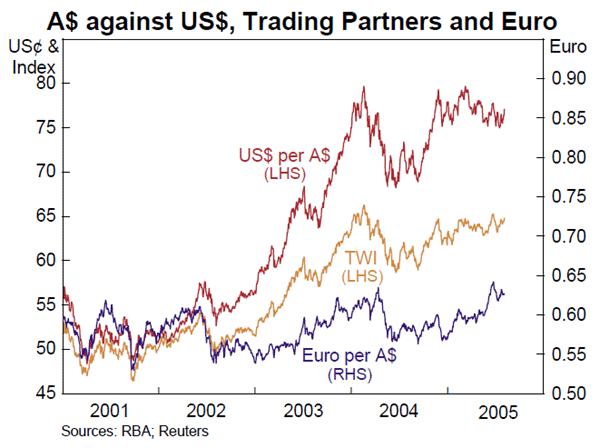
Against the US dollar, which as noted was on an upward trend through much of the period, the Australian dollar slipped a little in net terms. Apart from two weeks in July where it fell below US75 cents, it has generally stayed in the US75–80 cent range in which it has been trading since late 2004.
Against other currencies, the Australian dollar recorded some big moves (Graph 15). It rose by around 4 to 5 per cent against the euro and the yen, and 6 per cent against the UK pound, to reach multi-year highs. It also appreciated noticeably against the NZ dollar as expectations were scaled back of any further tightening in monetary policy there. The Australian dollar was affected temporarily by the Chinese exchange rate announcement in July, moving higher against the US dollar and other non-Asian currencies, but depreciating against Asian currencies. Most of these developments were unwound within a few days.
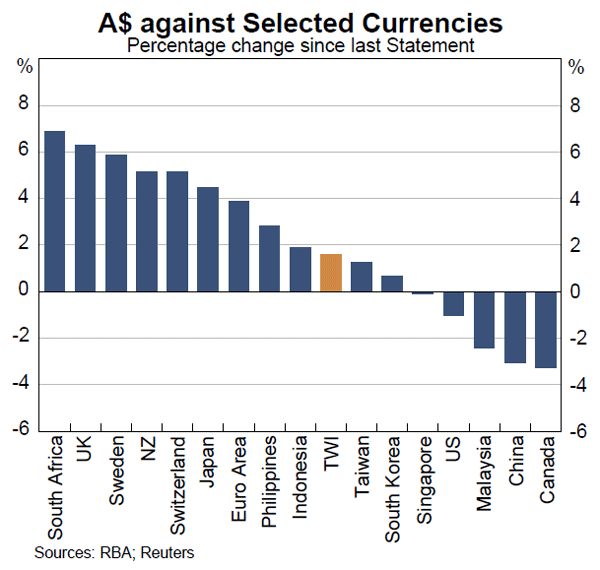
The favourable investor sentiment towards the Australian dollar is illustrated by the fact that speculative positions in the Australian dollar against the US dollar on the Chicago Futures Exchange remain net long, one of only two currencies for which this is the case (the Canadian dollar is the other). The net long positions were, however, smaller than earlier in 2005 (Graph 16).
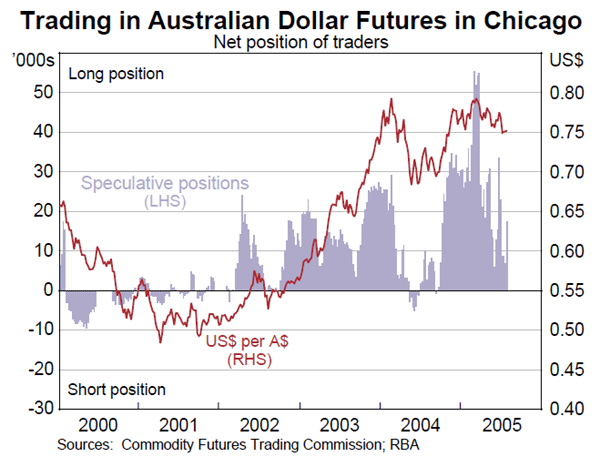
Volatility in the Australian dollar has increased since the last Statement, including around the time of the Chinese exchange rate announcement (Graph 17). However, estimates of volatility that market makers are pricing into options (so-called implied volatility) have not moved as significantly, suggesting that markets are unconvinced that the lift in volatility is likely to be sustained.
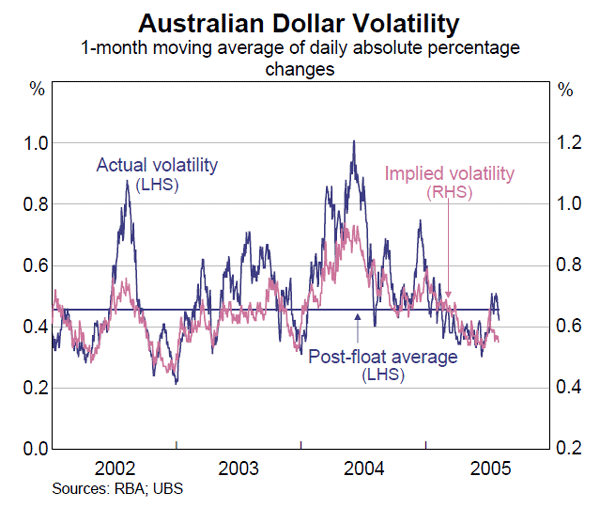
With official reserve assets at relatively comfortable levels and the Australian dollar mostly trading in a range of US75 to US80 cents since late 2004, the Bank has been opportunistic in adding further to its reserve holdings at attractive prices. Over the past quarter the Bank added a net $500 million to net reserves, with the largest purchases in June when the Australian dollar moved above US77 cents. Overall, net reserves increased from $26 billion at the end of April to $26½ billion at the end of July. The Bank's holdings of foreign exchange under swap agreements increased by around $5 billion over the three months to $30¾ billion, as the Bank continued to make use of swaps to help with domestic liquidity management.
Money markets
The US Federal Reserve raised the federal funds rate by a further 25 basis points, to 3.25 per cent, at its June meeting (Graph 18). The Fed has now raised the federal funds rate by 25 basis points at every meeting since it commenced tightening in June 2004, for a total increase of 225 basis points. Over the past three months, markets have brought forward their expectations of future tightening following indications that the US economy remains strong and the testimony to Congress by Chairman Greenspan. Currently market pricing anticipates the fed funds rate reaching 4 per cent by the end of the year, with little tightening priced in beyond that. A noticeable feature of the current tightening cycle, however, has been that the market has consistently underestimated the extent of the Fed's policy moves. Following each tightening since June 2004, the market has typically priced in a probability that the Fed would tighten at only about 75 per cent of meetings over the subsequent six months. As noted, in the event, the Fed has tightened at every meeting.
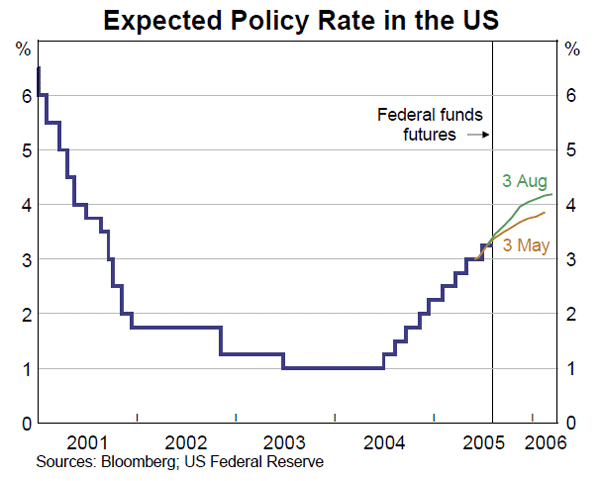
The European Central Bank (ECB) left its policy rate unchanged at 2 per cent over the past three months, as it has done since June 2003 (Graph 19). Through May and June, markets were pricing in the possibility of an interest rate cut by the end of the year, reflecting disappointing growth prospects in the euro area. However, recent comments from ECB officials downplaying the possibility of a rate reduction have seen these expectations revert to unchanged policy for the foreseeable future.
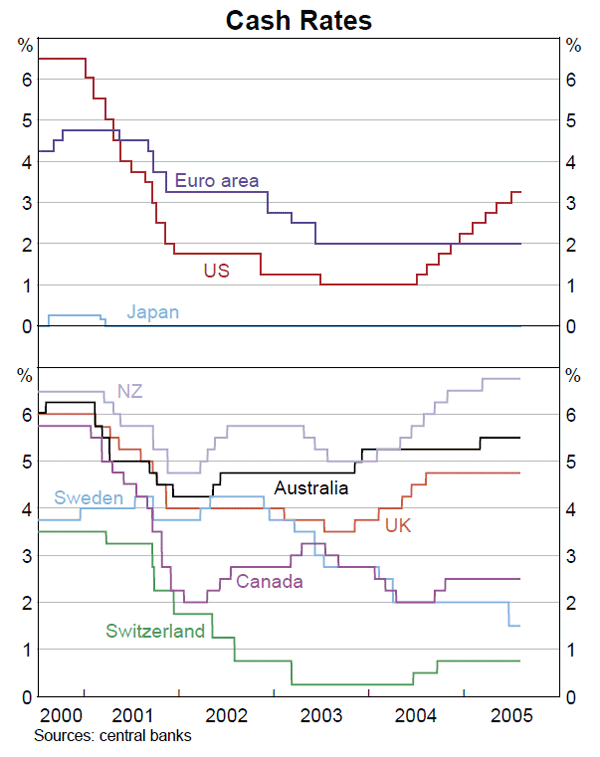
Similarly, the Bank of Japan (BoJ) has not changed monetary policy for several years, with interest rates remaining at zero. It has instead sought to boost the liquidity of the banking system by supplying excess reserves to banks. With the banking system and the economy on the mend, the BoJ is no longer as concerned to maintain excess liquidity and in May foreshadowed that it would allow banks' reserves to fall if demand for them declined. This change is largely technical in nature and has little implication for the overall stance of monetary policy.
While policy rates in the UK have remained unchanged over the past three months, four of the nine members of the Monetary Policy Committee of the Bank of England (BoE) voted for an interest rate cut at the latest meeting, reflecting weaker economic data and contained inflationary pressures. Currently, the market expects the BoE to reduce interest rates by 50 basis points over the coming months, to 4.25 per cent. Elsewhere in Europe, Sweden cut official rates in June by a larger-than-anticipated 50 basis points to 1.5 per cent, while Norway raised its official rate by 25 basis points to 2 per cent at its June meeting.
In other industrialised countries, policy settings in Canada and New Zealand have remained unchanged over the Statement period. However, expectations about future policy moves have changed in both countries. Reflecting comments by the Bank of Canada that a reduction in current monetary stimulus will be required in the near-term, markets currently expect rates to rise by 25 basis points, to 2.75 per cent, later in the year. In New Zealand there has been a notable scaling back in expectations for further rate rises.
In emerging markets, China introduced further administrative measures to address price pressures in the housing market, including a prohibition on the resale of unfinished properties until construction is complete, a sales tax on residential properties sold within two years of purchase, and the removal of land-use rights for sites that have remained idle for more than two years. Interest rates on foreign-currency-denominated deposits were also raised to stem speculative pressure on the renminbi at the same time as the exchange rate regime was changed.
Indonesia's central bank implemented a change in its monetary policy regime, shifting from a money supply target to an interest rate target. It has also adopted a formal inflation target of 6 per cent for the current year, and 5 per cent for 2006. In other emerging markets, Poland, Turkey and Hungary eased policy rates, citing reduced inflation concerns, while Thailand, Taiwan, Chile and Brazil tightened monetary policy due to rising inflationary pressures.
Bond yields
Over the past three months, yields on US 10-year bonds have risen from a little under 4 per cent to over 4¼ per cent following data indicating that US economic growth remains strong (Graph 20). Broadly, however, yields remain in the 4–4½ per cent range they have been in for much of the past year, even though the Fed has raised short-term interest rates by 225 basis points over the period. The small rise in nominal yields in the latest three months was due to an increase in real yields, as indicated by the yield on indexed bonds which is currently around 2 per cent.
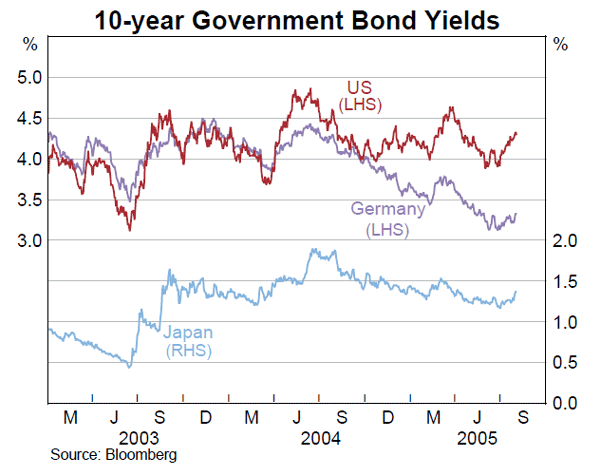
Euro area yields have remained at low levels over the past three months, reflecting the subdued growth outlook for the region. The spread between German 10-year government bonds and US Treasuries widened to around 100 basis points, to be the widest in five years. After reaching a new post-War low of 3.1 per cent, German yields rose a little following comments from ECB officials dispelling the possibility of an easing in monetary policy. Japanese government yields rose reflecting better-than-expected economic data and renewed optimism about the economic outlook.
Although they have risen a little recently, bond yields in global markets continue to trade at low levels by historical standards. The reasons for this continue to be debated by analysts. As discussed in the May Statement, the explanations that have been advanced to explain the low level of yields include a glut of savings, particularly in the Asian region, the low rates of inflation globally, increased credibility of central banks in controlling inflation which has reduced term premiums, and changes to pension fund arrangements which have encouraged a switch from investment in equities to bonds.
The widening in spreads of lower grade US corporate debt that occurred earlier in the year has been largely unwound over the past three months (Graph 21). The move up in US corporate spreads had been driven mainly by the automotive and automotive parts sectors as markets responded to the ratings downgrades of General Motors and Ford, but these concerns have now waned. Emerging market sovereign spreads declined, particularly in Latin America following the successful negotiation of a debt restructure by Argentina.
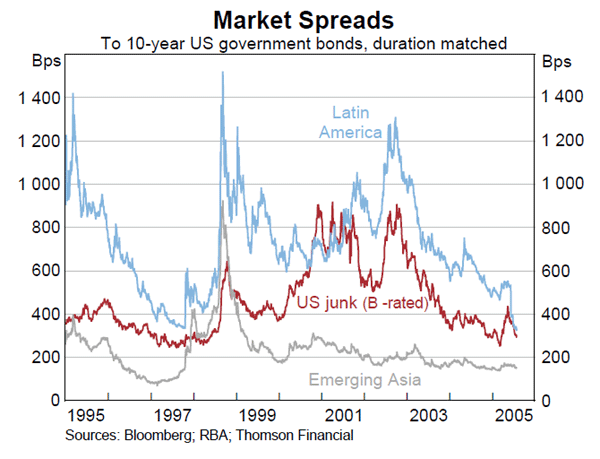
Equity markets
After a relatively lacklustre performance in the first part of 2005, global equity markets have risen strongly since the last Statement, reflecting renewed optimism about the sustainability of the US economic recovery and the outlook for world growth more generally (Graph 22). Equity markets in the US have risen by over 5 per cent over the past three months, with the technology dependent NASDAQ rising to a four-year high aided by better-than-expected earnings reports by key stocks.
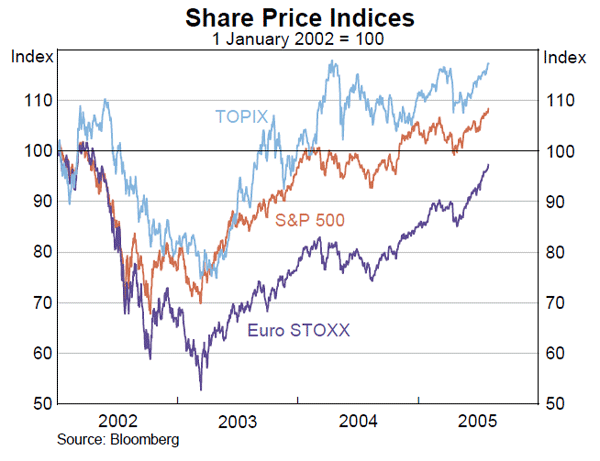
Notwithstanding the weak economic conditions and outlook in Europe, the corporate sector in that region is achieving good financial outcomes and equity markets in the region have generally outperformed other major markets by a considerable margin over the past three months and over the year as a whole (Table 4). The Euro STOXX index has risen by more than 10 per cent since the last Statement, while in the UK the FTSE has recorded only a slightly smaller rise, notwithstanding a short-lived decline following the London bombings. Japanese equities have also risen solidly. The improved economic outlook for Japan has been generally favourable for equities, although high commodity prices have limited the gains.
| Change since 2000 peak |
Change since 2003 trough |
2005 to date | Since the last Statement |
|
|---|---|---|---|---|
| United States | ||||
| – Dow Jones | −9 | 42 | −1 | 4 |
| – S&P 500 | −18 | 55 | 3 | 7 |
| – NASDAQ | −56 | 74 | 2 | 15 |
| Euro area | ||||
| – STOXX | −34 | 85 | 14 | 13 |
| United Kingdom | ||||
| – FTSE | −23 | 62 | 11 | 10 |
| Japan | ||||
| – TOPIX | −31 | 57 | 5 | 7 |
| Canada | ||||
| – TSE 300 | −7 | 70 | 15 | 13 |
| Australia | ||||
| – ASX 200 | 30 | 62 | 8 | 10 |
|
Source: Bloomberg |
||||
Share prices in emerging Asia and Latin America have also on average risen strongly since the previous Statement. In Asia, the Indian share market recorded very sharp gains of around 25 per cent, while share prices in Korea, Singapore, Taiwan and Indonesia also experienced double-digit growth over the period.
The one main exception to the strength in global equity markets has been China, where despite the very strong growth in the Chinese economy, concerns about how the government will dispose of its holdings of non-traded shares in state-owned enterprises have depressed the market (Graph 23). China's foreign-currency denominated B Shares, (which are available to both foreign and domestic investors) have fared particularly poorly, declining by around 15 per cent over the past three months. However China's local currency denominated A Shares (which are restricted to local investors and approved foreign investors) have fallen somewhat less, declining by around 5 per cent over the same period.
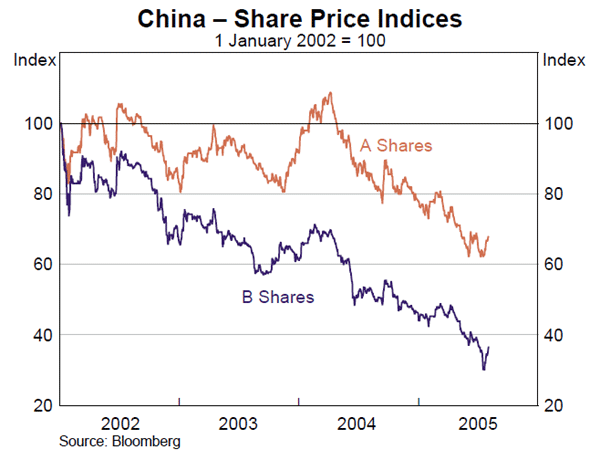
Domestic Economic Conditions
Growth in domestic expenditure has slowed over the past few quarters, but still continues at a solid rate. Gross national expenditure (GNE) increased by 1 per cent in the March quarter and by 3½ per cent over the year, compared with 6¼ per cent over the previous four quarters (Table 5). This slowing in demand partly reflected a softening in household consumption, perhaps a result of balance sheet consolidation by some households. The downturn in dwelling construction was also an important driver of the slowing, as was the fall in spending on equipment investment in the March quarter after strong growth in this component in earlier quarters.
| June qtr 2004 |
September qtr 2004 |
December qtr 2004 |
March qtr 2005 |
Year to March qtr 2005 |
|
|---|---|---|---|---|---|
| Domestic final demand | 1.1 | 1.0 | 1.3 | −0.1 | 3.4 |
| Change in inventories(a) | −0.4 | −0.3 | −0.4 | 1.2 | 0.1 |
| GNE | 0.8 | 0.8 | 0.9 | 1.0 | 3.5 |
| Net exports(a) | 0.2 | −1.0 | −0.7 | −0.3 | −1.9 |
| GDP | 0.7 | 0.2 | 0.3 | 0.7 | 1.9 |
| Memo item: | |||||
| Real GDI(b) | 1.2 | 0.6 | 0.7 | 0.9 | 3.5 |
|
(a) Contributions to GDP growth Source: ABS |
|||||
Net exports continued to subtract from growth in the March quarter, but to a lesser extent than in 2004, as exports grew solidly and growth in imports moderated a little. Overall, real GDP is estimated to have risen by 0.7 per cent in the March quarter, and by a little less than 2 per cent over the year. Growth in the non-farm sector was somewhat stronger, at 2½ per cent, with total production restrained by a 16 per cent drop in farm GDP. The terms of trade continue to impart a significant stimulus to income, such that real gross domestic income increased by 0.9 per cent in the March quarter and by 3½ per cent over the year.
The economy seems likely to remain on a moderate growth path through 2005. The large gains in the terms of trade should continue to support domestic spending, and the recent rainfalls suggest that farm production is unlikely to fall to the extent that was earlier feared. Growth in household consumption may persist at more moderate rates than seen over recent years, but it should be supported by favourable labour market conditions and consumer sentiment, as well as the boost to incomes from recent Budget initiatives. Further, recent data have tended to confirm the expectation that the downturn in housing construction will be much milder than in past cycles. Similarly, while some indicators point to an easing in business investment growth, sentiment and profitability in the business sector remain positive, and capacity utilisation levels are high. A slowing in domestic demand growth to more sustainable rates, coupled with signs of a recovery in exports, should reduce the drag on growth from net exports.
Household sector
Household consumption has slowed from the unsustainable rates seen in 2003 and early 2004, but its pace of growth has been fairly solid so far in 2005. In the March quarter, consumer spending rose by 0.8 per cent to be 3½ per cent higher over the year, which compares with the peak annual growth rate of more than 6 per cent in early 2004. Expenditure on goods increased by 1½ per cent in the quarter, while growth in spending on services slowed further. More recently, the volume of retail sales rose by a modest 0.2 per cent in the June quarter, partly reflecting a dip in sales at the start of the quarter, as warmer than usual weather depressed sales by department stores and clothing & soft goods retailers; higher petrol prices are also likely to have weighed on consumer spending in the quarter (Graph 24). Motor vehicle sales fell by 1.9 per cent in the June quarter, but this follows the boost to sales from the tariff cut at the beginning of the year, and the level of sales remains high. The Westpac-Melbourne Institute measure of consumer sentiment has eased since the start of 2005, though it is still above long-run average levels.
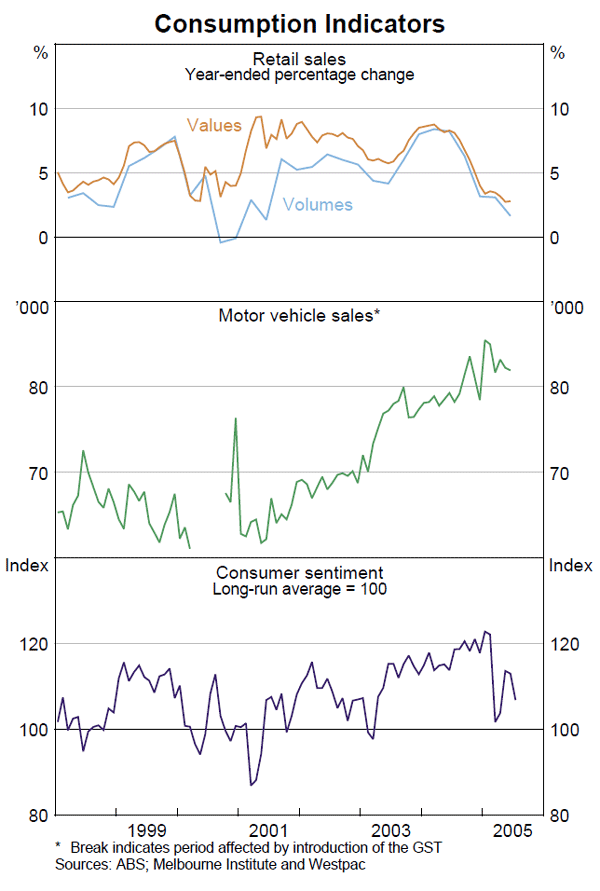
Household income growth has moderated relative to the rates of a year or two ago, but continued strength in the labour market, the tax cuts on 1 July and other fiscal measures in the May Budget all suggest that incomes and consumer spending will remain well-supported in the period ahead. There are nonetheless a few signs that some households are becoming more financially cautious, after a long period in which debt and debt-servicing costs rose rapidly (Graph 25). The household saving ratio increased slightly over the year to the March quarter, after declining for many years. Although debt growth continues to outpace that of income, it has slowed to its lowest quarterly rate in more than six years. Some indicators of financial stress – such as loan arrears – have risen a little, though they remain low relative to historical experience. The household sector switched to injecting equity into housing in the quarter after four years of equity withdrawal (Graph 26). As was the case during the upswing in equity withdrawal, not all of this turnaround is likely to be reflected in consumption spending, as households may have also used these funds for other purposes such as the purchase of financial assets.

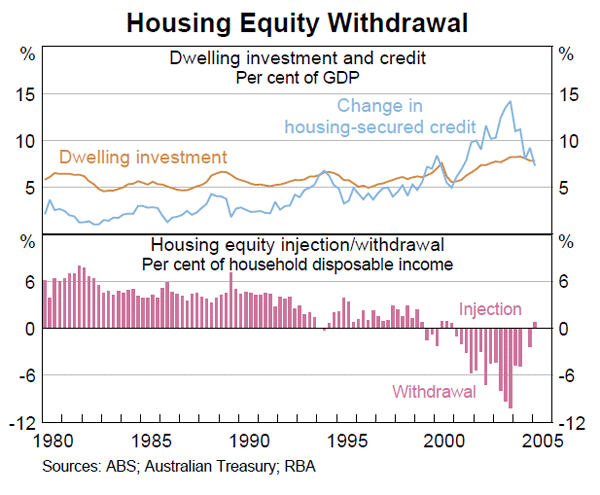
Housing
Construction
Following falls in building approvals from late 2003 and in commencements from mid 2004, the downturn in residential building has continued into 2005. Dwelling investment recorded a further decline in the March quarter, contracting by ½ per cent to be nearly 4 per cent lower over the year. Both new dwelling construction and alterations and additions activity fell in the quarter, and industry surveys, such as that by the Master Builders Association, suggest that further modest falls in residential building construction are likely in coming quarters. In the current cycle, both building approvals and commencements have fallen by around 15 per cent from their peaks, while new dwelling construction to date has fallen by only 6 per cent. Nevertheless, the large amount of work in the pipeline should continue to provide support to construction in the short term. This is consistent with the relatively optimistic responses of builders to industry surveys about their own near-term prospects.
Forward indicators of housing construction have generally stabilised over recent months. The downturn in building approvals looks to have largely run its course, supporting earlier expectations for a relatively mild downturn in dwelling activity by historical standards. After remaining flat during late 2004, the number of building approvals for houses picked up in the three months to June, to reach similar levels to those seen a year earlier (Graph 27). In recent months, the number of loan approvals for new construction has increased and the Housing Industry Association's measure of new home sales (which are commitments to build) has picked up, driven by strength in Western Australia and Victoria. Indicators of construction in New South Wales, however, generally remain subdued. In most states, incentives offered by state governments appear to have attracted re-entry of first-home buyers. Approvals in the volatile medium-density sector stabilised in the first half of 2005, but remained around 10 per cent lower than the average in 2004. The value of approvals for alterations and additions remains weak, and is well below the peak in July 2004.
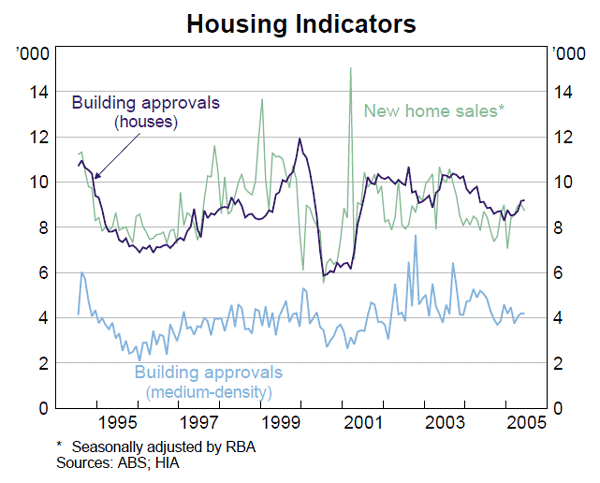
Financing and prices
Lending for housing remains above its 2004 average, but has softened in recent months, perhaps in part a response to the rising debt-service burden. The value of monthly housing loan approvals has fallen steadily since its 2005 peak of $14.1 billion in February, to $13 billion in May (Graph 28). Both the owner-occupier and investor components have fallen, but the decline has been most marked in the investor component. Housing credit growth continues to moderate, running at an annualised rate of 10.9 per cent in the six months to June, around half the peak rates seen in late 2003.
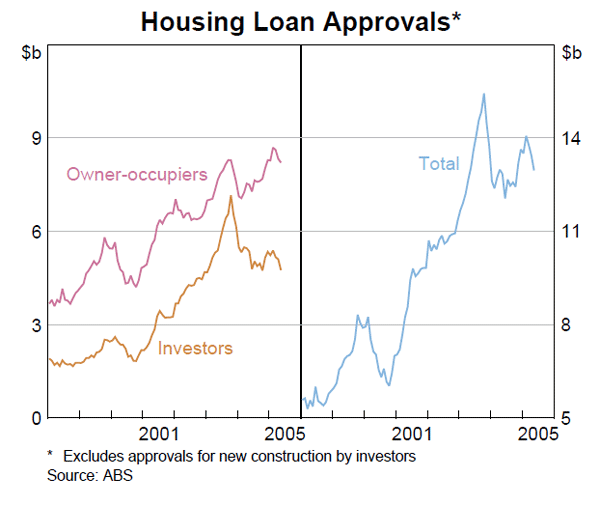
The various measures of nationwide house prices suggest little change in prices in the March and June quarters. House prices in Sydney and Melbourne are either unchanged or slightly weaker and continue to weigh on the nationwide measure. Prices have been broadly flat in the other capitals, with the exception of Perth, where they continue to rise (for more detail, see ‘Box B: Recent Developments in Housing Prices’). Recent auction results also suggest subdued demand. Across all capital cities, auction clearance rates have been broadly the same as, or a little higher than, at the same time last year, but they remain significantly weaker than their recent historical averages. Anecdotal reports suggest that the small increases in auction clearance rates in some cities reflect greater recognition by vendors of the softer market conditions relative to the boom conditions of 2003. Auction volumes in Melbourne and Sydney remain similar to this time last year, but weaker than seen in previous years.
Recent data point to firmer conditions in rental housing markets. Vacancy rates in all state capitals have been trending down and in the March quarter stood around or below their average levels since the start of the 1980s. Data from the Consumer Price Index point to continued modest growth in rents; however, data from the REIA and state tenancy authorities suggest a pick-up in median weekly rents for three-bedroom houses over the year to the March quarter, and modest increases in rents for two-bedroom apartments. Despite strengthening conditions in rental markets and subdued house prices, rental yields remain very low.
Business sector
The business sector overall continues to experience generally favourable conditions, although the various surveys still point to an easing in conditions since late 2004 (Graph 29). The June quarter NAB survey of the non-farm sector reported that business conditions were steady in the quarter and remain consistent with solid production growth. Capacity utilisation remains at high levels, particularly in the mining sector, while a large number of firms continue to cite the availability of suitable labour as a key constraint on output (Graph 30). The June quarter ACCI Survey of Investor Confidence, which also covers the non-farm sector, likewise reported that business conditions have eased, but remain at above-average levels, while expected conditions for respondents' own businesses remain around long-run levels. Similar trends have been seen in the Sensis survey of small and medium businesses, though assessments of current and future conditions are generally more subdued. Lack of work and sales have become more of a concern among respondents, consistent with some slowing in domestic demand, though the ability to find quality staff remains a significant issue. Consistent with business surveys, capacity constraints continue to be reported in liaison and are affecting the ability of firms to expand production in some industries. However, as the housing cycle matures, capacity constraints are reported to have eased in the residential construction industry.
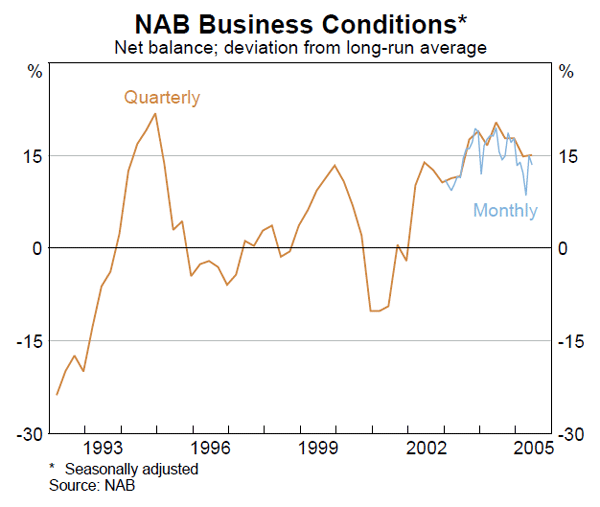
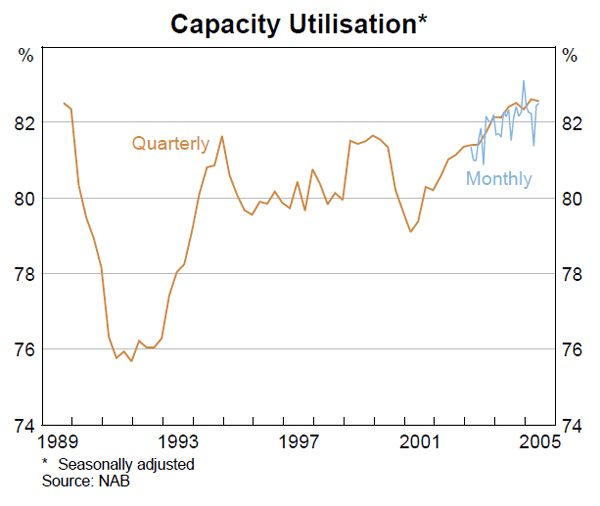
In line with trends in the wider economy, the manufacturing sector has also reported weaker conditions compared with late 2004, but the surveys suggest broadly unchanged conditions in the June quarter. According to the latest ACCI-Westpac survey of manufacturers, actual business conditions in the manufacturing sector improved slightly in the June quarter 2005. Both actual and expected business conditions remained above long-run levels, but were down on the high levels seen towards the end of last year, while business confidence was more subdued. The latest quarterly AIG survey of manufacturing was somewhat more pessimistic, suggesting that activity in the sector weakened slightly in the June quarter, with key indicators at or below long-run levels. More recently, the AIG Performance of Manufacturing Index fell sharply in July to be well below its long-run average.
Following protracted dry conditions, prospects for the farm sector have improved in recent months. National forecasts made prior to recent rains predicted a below-average wheat crop, but more recent forecasts by state departments of agriculture and private-sector agencies now suggest that it will be close to the average of the past five years. Encouragingly, the Bureau of Meteorology suggests that the risk of El Niño conditions emerging later this year has fallen sharply in recent months. However, risks to the outlook appear to be on the downside, given that yields tend to be much lower when planting is late, and because the extent of rain prevented planting in some cases. Furthermore, while the rains have improved the outlook for both grain and livestock production, they have done little to alleviate the critical shortage of stored water. Consequently, much of eastern Australia remains drought-declared.
Corporate profitability remains strong, with above-average growth around the turn of the year leaving gross operating surplus of private non-financial corporations 8.3 per cent higher over the year to the March quarter. This reflects the fact that profits of mining firms have been growing particularly strongly, benefiting from robust world demand and strong commodity prices (Graph 31). The recent large increases in bulk commodity prices will continue to affect revenues and profits over the coming year. Meanwhile, profit growth in the domestically focused sectors has slowed over the past year, largely reflecting the moderation in domestic demand and rising costs. The profitability of the unincorporated sector weakened in the quarter, to be 1.5 per cent lower over the year, mainly resulting from subdued conditions in the farm sector.
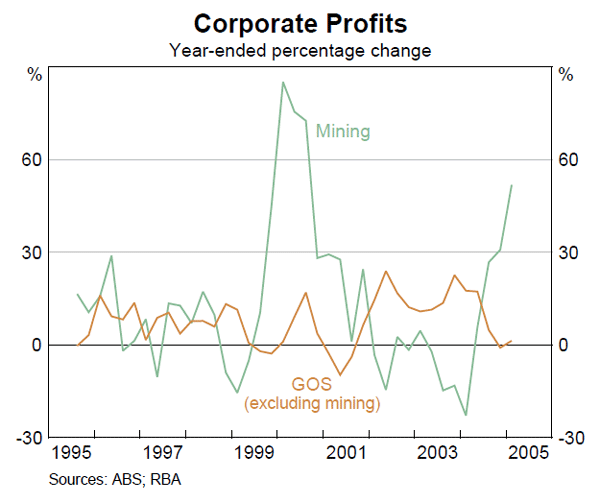
Businesses continue to have ample access to external financing. Business credit has been strong, growing by 11½ per cent over the year to June, while non-intermediated debt outstanding increased by around 18 per cent. Meanwhile, net equity raisings have generally been above their five-year average over the past six months, though some occasional large equity buybacks have partly offset this. These buybacks most likely reflect the recent strong profitability of many firms, which has resulted in them accumulating surplus cash reserves.
Buoyed by strong profitability and high capacity utilisation, business investment has enjoyed a strong upswing over the past three years (Graph 32). Most recently, investment declined in the March quarter 2005, but this follows rapid growth in the December quarter and the level of investment is still more than 10 per cent higher than a year earlier. Machinery and equipment spending fell sharply in the quarter as imports of civil aircraft fell from their high December quarter level. In contrast, non-residential construction activity grew solidly, with further strong growth in engineering construction more than offsetting a modest decline in the building component.
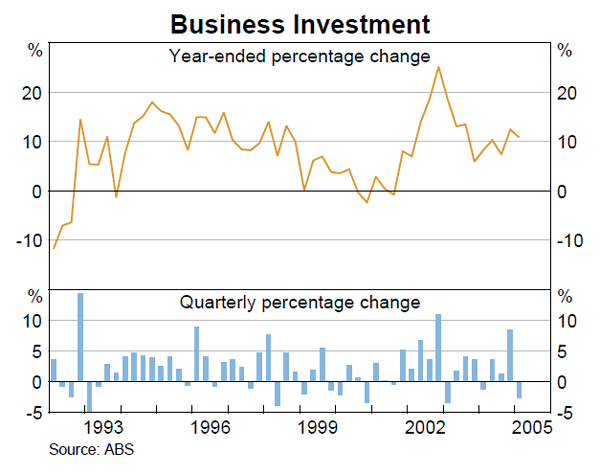
The favourable conditions underpinning recent growth in business investment remain in place, including a positive external funding environment, with sharply higher commodity prices adding further support to profitability. Nevertheless, survey indicators of firms' investment intentions point to some divergence in the outlook for the different components of investment, with a marked easing in the pace of real equipment investment growth compared with previous years, as the investment cycle matures, and continued strength in engineering construction.
While it is only a preliminary indicator of actual spending at this stage, the latest capital expenditure (Capex) survey points to a levelling out in machinery and equipment investment in 2005/06, following strong growth in 2004/05. Within the total, equipment spending intentions for the manufacturing sector point to a solid rise, consistent with the above-average level of spending suggested by the ACCI-Westpac survey of manufacturers. Industry bodies also report a notable increase in the volume of farm equipment purchased in recent months, and the latest Rabobank survey suggests that investment intentions for farm equipment (which are not covered in the Capex survey) are close to their pre-drought levels.
Forward-looking indicators of non-residential construction point to further growth in coming quarters. Growth in engineering construction activity is expected to be supported by work currently underway on a number of large road construction and resource-related projects, such as the EastLink motorway in Melbourne ($2.5 billion) and Alcan's alumina refinery expansion in the Northern Territory ($1.9 billion). In contrast, the near-term outlook for building activity is weaker, with the recent level of work approved running a little below the current high level of construction.
Australian Government Budget
The Australian Government Budget for 2005/06, delivered in May, showed a considerable increase in the expected budget surplus in both underlying cash and accrual terms (Graph 33). This upward revision reflects a larger revenue base in 2004/05 – owing to stronger than expected employment growth through 2004 – and higher forecast company taxation revenue, partly driven by the stronger outlook for the terms of trade. These effects more than offset a range of new policy measures announced in the Budget, including further personal income tax cuts, an increase in assistance through the Family Tax Benefit, a range of measures aimed at improving workforce participation, and higher spending on defence and national security. The budget aggregates imply that the fiscal position of the Australian Government will be little changed in 2005/06 and therefore will have a broadly neutral effect on the growth in demand. State government budgets in aggregate are estimated to have a mildly expansionary impact, underpinned by increased infrastructure investment.
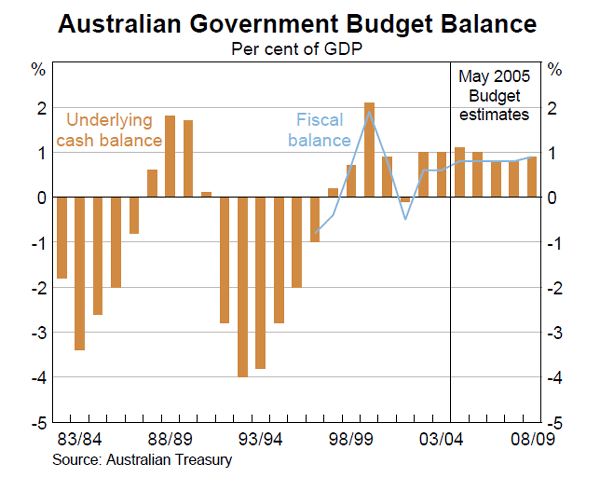
Labour market
Strong labour market conditions persisted in the June quarter. Employment rose by 3.4 per cent over the year, bringing total employment to just over 10 million in June (Graph 34). Full-time employment continued to accelerate, increasing by 3.3 per cent over the year. The employment expansion over the first six months of 2005 was accompanied by a rise in the participation rate of three-quarters of a percentage point, while the unemployment rate fell from 5.1 per cent to 5.0 per cent.
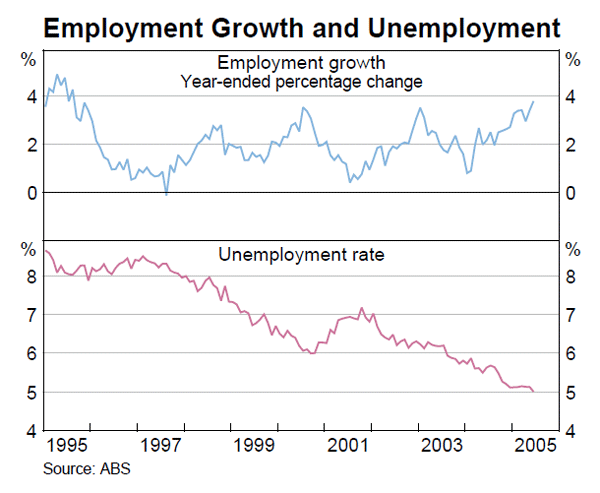
There has been some convergence in labour market conditions across the mainland states since the beginning of 2005 (Table 6). Employment growth in New South Wales, which has persistently lagged the other states, increased to 1.7 per cent over the year to the June quarter, buoyed by a recovery in the business services sector. Employment growth in Queensland moderated to 5.6 per cent, but remains at the top of the range of state outcomes, closely followed by growth in Western Australia. In addition, the states with the highest unemployment rates mid last year have experienced the largest falls over the past year.
| Employment growth | Unemployment rate | ||||
|---|---|---|---|---|---|
| June qtr 2005 | Year-ended June qtr 2005 |
June qtr 2004 |
June qtr 2005 |
||
| NSW | 0.7 | 1.7 | 5.5 | 5.1 | |
| Victoria | 0.9 | 3.6 | 5.6 | 5.4 | |
| Queensland | 0.6 | 5.6 | 5.8 | 5.0 | |
| WA | 1.6 | 5.3 | 5.1 | 4.8 | |
| SA | 0.9 | 3.1 | 6.2 | 5.0 | |
| Tasmania | 0.2 | 2.8 | 6.8 | 6.1 | |
| Australia | 0.8 | 3.4 | 5.6 | 5.1 | |
|
Source: ABS |
|||||
Employment in most industries continued to expand over the year to the June quarter, with employment growth of more than 5 per cent in the mining, retail and construction industries. In addition, the contribution from service industries strengthened, as the recovery in business services employment continued and employment in most household services industries rebounded. Outcomes in the education, manufacturing and rural sectors weighed on aggregate employment growth.
Forward-looking labour demand indicators moderated over the June quarter, but generally remain at high levels suggesting further, but more moderate, near-term gains in employment. The NAB and ACCI-Westpac measures of employment intentions remain above long-run averages, although the ACCI-Westpac measure eased again in the June quarter (Graph 35). The ABS measure of vacancies decreased slightly in the June quarter, but as a proportion of the labour force it is still considerably higher than a year ago. According to the ANZ measures, the number of internet-based vacancies has eased only slightly from its peak in late 2004, while print-based vacancies in June were below levels seen a year ago. Liaison reports suggest that skill shortages in specialised occupations are still acute. Shortages are becoming more widespread across industries and occupations, but remain most pronounced among skilled workers in the non-residential construction and resources sectors, and in parts of the business services sector.
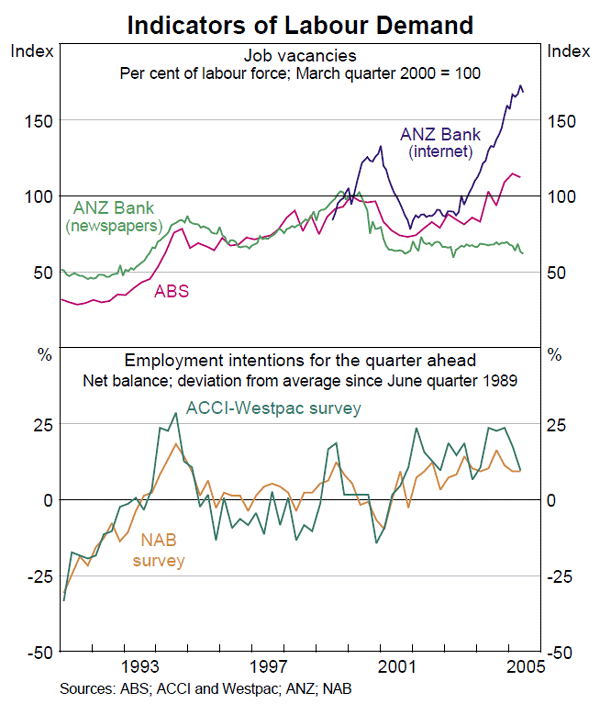
Box B: Recent Developments in Housing Prices
It is now around 1½ years since the sharp cooling in the boom in Australian house prices. This box outlines some new data that have been compiled to provide a better measure of median house prices. It then surveys price developments since the market peak, both nationwide and in the major capitals, and their impact on the broader economy.
New data on house prices
Analysis of short-term developments in Australian house prices in recent years has been hampered by two major problems.[1] The first has been data timeliness. From an economic standpoint, it is desirable for house price data to be based on the period in which the price was determined (i.e. at contract exchange) rather than when the transaction was subsequently settled. In the absence of a reporting requirement at the time of sale, it has been necessary to rely on data collected by state governments after settlement has occurred.[2] This is usually several months after the transaction was agreed to, with information becoming available only very gradually. Furthermore, it has become apparent that the early samples are often quite unrepresentative and could provide a biased estimate of price developments in the eventual full sample of sales.
The second problem is the more general one of compositional change. Most of the house price series used in Australia are based on city-wide median prices.[3] However, measures of median (or mean) prices are dependent on the sample of transactions in the period in question. There is evidence of substantial shifts in sample composition in some cities, with some quarters having a high proportion of sales in higher-priced suburbs and other quarters having more sales in lower-priced suburbs. For example, in Sydney, nearly three-quarters of the variation in quarterly median prices can be attributed to compositional shifts between higher and lower-priced suburbs, rather than reflecting pure price changes.
To overcome these problems, the Bank commissioned Australian Property Monitors (APM) to put together some new data on median house prices in major capitals stratified by market segment. To counter the problem of limited availability of data in the months immediately after the close of the most recent quarter, the data from state governments have been augmented with APM's own collection of data on auction and private treaty sales. This has the effect of significantly increasing the sample size for the most recent quarter: for the June quarter 2005, the sample size is more than doubled for Melbourne where the problem of slow reporting is most pronounced.
To address the more general problem of compositional change, sales in each quarter in each of the capital cities were sorted into ten different groups (five for Canberra) based on the longer-term median sales price for the suburb in which the property was located. Stratifying sales into groups in this way ensures that each group consists of a much more homogenous set of houses than the city-wide sample of all sales. Median prices in each of these individual groups can then be combined to provide an estimate of price developments in the overall market that is far less affected by compositional change than a conventional city-wide median measure.
The combination of the use of data on additional sales, and the stratification of all sales into groups, results in a measure of median house prices for each city that is substantially less volatile than a conventional median and subject to much less seasonality (Graph B1). It is also considerably less subject to revision, even when initial estimates are made soon after the end of a quarter.
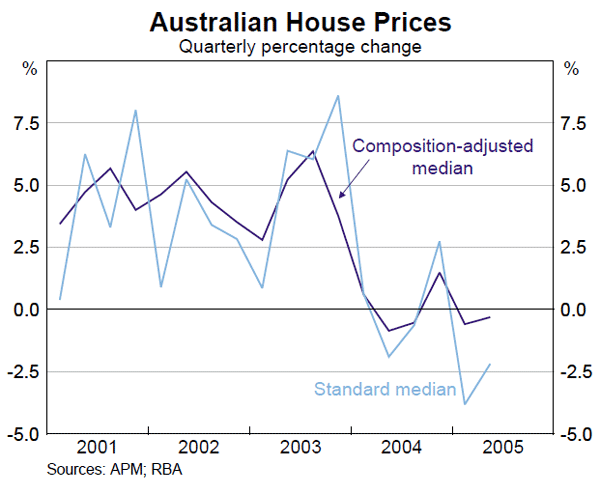
Recent developments in prices
The resulting new median price series confirm that there has been a marked cooling in nationwide house price growth over the past 18 months (Table B1 and Graph B2). In the 18 months prior to the December quarter of 2003, average nationwide prices rose by nearly 30 per cent, but they have been flat in the 18 months since then.
| 18 months to Dec qtr 2003 | 18 months to Jun qtr 2005 | |
|---|---|---|
| Sydney | 25 | −7 |
| Melbourne | 20 | 0 |
| Brisbane | 62 | 5 |
| Adelaide | 35 | 9 |
| Perth | 33 | 19 |
| Canberra | 41 | 0 |
| Australia | 29 | 0 |
|
Sources: APM; RBA |
||

This pattern of rapidly rising prices followed by a noticeable slowdown in house price growth is evident, albeit to varying degrees, in each of the capitals. Indeed, it is also evident in every group of suburbs in every capital. Average city-wide prices have fallen or remained unchanged in Sydney, Melbourne and Canberra over the past 18 months. There has been only modest growth in Brisbane over this period, which is a very sharp slowdown from the prior period when prices rose by around 60 per cent. Growth in Adelaide and Perth has also slowed, but in contrast to the other capitals, prices continued to rise at a solid rate over the most recent 18 months, especially in Perth which has clearly benefited from the strength of the resources sector.
Composition-adjusted measures of apartment prices in Sydney and Melbourne, which together account for around 70 per cent of the total capital-city apartment stock, have followed a broadly similar pattern to house prices. Apartment prices rose solidly in the 18 months to the December quarter 2003, but have fallen over the past 18 months.
The divergent experience in house prices over the past 18 months appears to be partly related to the extent and timing of the prior build-up in prices. The boom started first in Sydney and Melbourne, with these capitals showing significant growth from 1996. Cumulative growth in house prices from late 1995 to late 2003 was strongest in these two capitals and in Canberra, with prices increasing by around 12 to 13 per cent per year on average in this period. These are also the three cities where house prices have been weakest since late 2003. By contrast, the boom in Perth started later and the cumulative price gain until late 2003 was noticeably less than in other capitals, with prices rising by 9 per cent per year on average over this period. So it may not be surprising that price growth has been strongest in Perth in the subsequent period.
Although it is difficult to reach conclusive judgements on the extent of possible overvaluations in house prices, two measures that are sometimes used to shed light on this issue are the ratios of house prices to labour incomes and to rents. In each case, these ratios suggest that housing valuations may have been most stretched in late 2003 in Sydney and Melbourne. For example, the ratio of capital city house prices to (state-wide) annual earnings had risen sharply in these two cities, to levels well above those in the other capitals (Graph B3).[4] Similarly, gross rental yields had also fallen to particularly low levels in these cities (Graph B4). Hence the price weakness in the two largest cities over the past 18 months appears to partly reflect an unwinding of earlier unsustainable movements in prices.
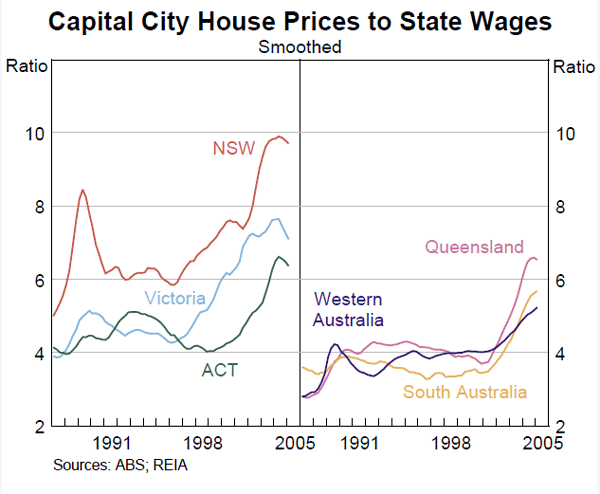
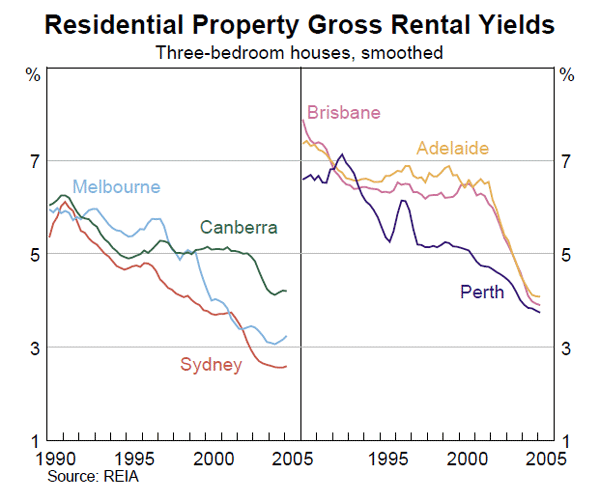
The relationship between house prices and the broader economy
Given the importance of housing in the macroeconomy, it is not surprising that the sharp slowing in the growth of house prices has been associated with a slowing in the growth of domestic demand. The earlier long boom in house prices was accompanied by a sharp rise in residential building activity. However, this was reversed with the cooling of the price boom, with the number of nationwide private residential building approvals falling by 11 per cent between the December quarter 2003 and the June quarter 2005, despite picking up in the first half of 2005. House price developments appear to have also had broader effects on spending by households. Whereas nationwide real retail sales had risen by nearly 10 per cent in the 18 months to the December quarter 2003, growth slowed to 4½ per cent over the period to June 2005. Although the state-level data for building approvals and retail trade data are fairly volatile, state developments do tend to be correlated with house price developments (Table B2). For example, activity in Western Australia has remained stronger than the nationwide average while activity in NSW and the ACT has been relatively weak, consistent with developments in house prices.
| Composition-adjusted house prices(a) |
Residential building approvals |
Real retail sales | |
|---|---|---|---|
| NSW | −7 | −23 | 2 |
| Victoria | 0 | 1 | 7 |
| Queensland | 5 | −10 | 4 |
| South Australia | 9 | −20 | 2 |
| Western Australia | 19 | −5 | 9 |
| ACT | 0 | −41 | 2 |
| Australia | 0 | −11 | 4 |
|
(a) Refers to movements in capital city house prices for each state. Sources: ABS; APM; RBA |
|||
Of course, developments in house prices have not been the only cause of the different outcomes experienced by state economies over the recent period. Nor has the impact been completely from house prices to economic developments, as opposed to vice versa. However, the state-level data are consistent with developments in house prices having had major direct and indirect effects on the Australian economy and having contributed to the recent slowing in the growth of domestic demand. As the Bank has noted in other contexts, this slowing in demand is part of a consolidation of household balance sheets and was unavoidable given the sharp run-up in household borrowing that accompanied the rapid increase in house prices. The correction in the housing market appears so far to have proceeded reasonably smoothly, and the prospect of an excessive and unwelcome slowing in domestic demand has been reduced by the boost to national incomes coming from the favourable terms of trade.
Balance of Payments
After several years of lacklustre performance, growth in the volume of Australia's exports has recently shown some signs of recovery, led by an increase in resource exports, while growth in import volumes has slowed somewhat in the first half of 2005. At the same time, Australia has continued to benefit from favourable movements in external prices, and the terms of trade are estimated to have increased by a further 5½ per cent in the June quarter. As a result, Australia's trade deficit is likely to have narrowed considerably in the June quarter to around 2¼ per cent of GDP which, if confirmed, would be the smallest deficit recorded for nearly three years (Graph 36). Assuming the net income deficit has remained unchanged as a share of GDP during the June quarter, this would imply a decline in the current account deficit to around 6¼ per cent of GDP, from more than 7 per cent in the March quarter.
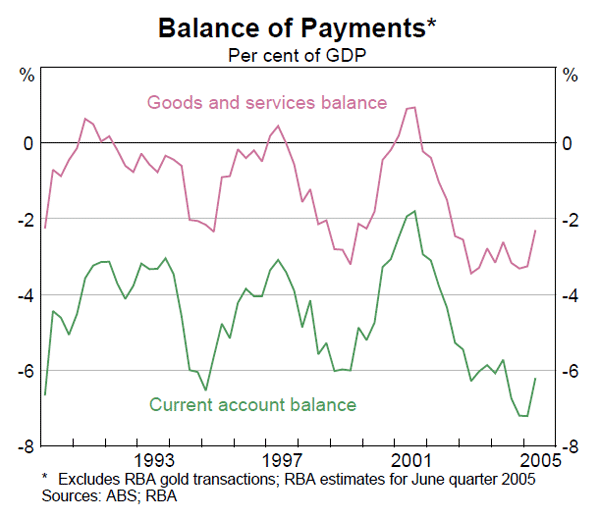
Exports
Export earnings increased by 14 per cent over the year to the June quarter, due to strong growth in prices and a modest recovery in volumes. The pick-up in volumes has been concentrated in resource exports, as several mining-related projects have come on-line, although manufactured exports also posted solid growth supported by robust global demand (Graph 37). In contrast, rural and services exports have both fallen over the year.
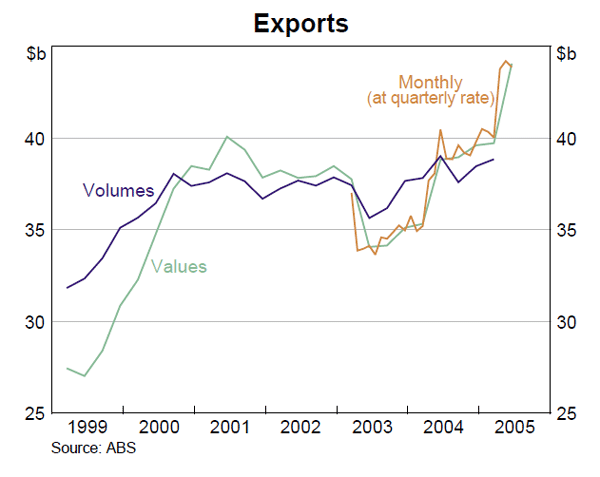
Rural export earnings declined by 13 per cent over the year to the June quarter, with a fall in cereals exports more than offsetting strength in meat export earnings. Nonetheless, there are signs that rural exports are beginning to stabilise: the value of rural exports increased by around 5½ per cent in the June quarter, and recent rainfall in southern and eastern Australia has improved the outlook for rural production. Further, the discovery of another case of BSE in the US may increase demand for Australian beef.
Resource export earnings increased by 40 per cent over the year to mid 2005, reflecting growth in commodity prices, especially for iron ore and coal. Earnings have also been supported by expansions of capacity in the production of commodities such as iron ore, LNG and other petroleum products. These trends were particularly evident in the June quarter, with the value of resource exports increasing by 25 per cent (further discussed in the commodity prices section below). As noted in the February Statement, the outlook for resource export volumes is favourable: external demand remains firm; there are a large number of new projects due to commence production; and some easing of transport infrastructure constraints appears to be underway.
The value of manufactured exports increased by 7½ per cent over the year to mid 2005. Growth was particularly strong in the June quarter, but this appears to reflect some special factors. After increasing in the March quarter, the volume of services exports appears to have fallen back in the June quarter. Looking through the volatility, services exports are broadly unchanged from their level of 2001. Recent weakness in travel services exports has reflected a decrease in the average expenditure of visitors over the past year, which has more than offset an increase in the number of visitor arrivals. Nonetheless, the outlook for tourism-related services exports appears positive, with trading partner growth expected to remain firm.
Imports
The growth in import volumes has slowed moderately this year, reflecting the slowing in the growth of domestic spending. Import volumes grew by 10 per cent over the year to the March quarter, with contributions from all major goods categories as well as services (Graph 38). More recently, the value of imports increased by 4 per cent in the June quarter, although this growth appears to have been concentrated in the volatile fuels & lubricants and civilian aircraft components. Imports of consumption goods have levelled out following the stimulus last quarter when tariffs on imports of passenger motor vehicles and textiles, clothing & footwear were reduced.
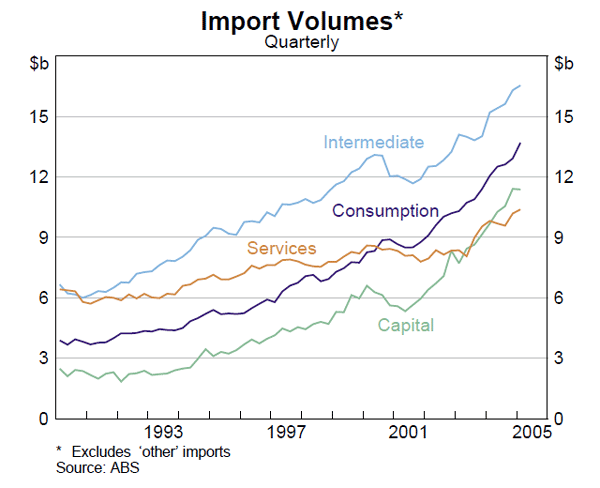
Net income
The net income deficit (NID) widened slightly in the March quarter, to reach $8.4 billion or 3.9 per cent of GDP (Graph 39). Over the year, the NID increased by $2.6 billion (1 per cent of GDP), predominantly reflecting higher payments to foreign holders of both Australian debt and equity. The rise in payments on Australia's foreign debt liabilities over the year was broadly in line with increases in the stock of debt, while higher payments on foreign equity holdings reflected strong earnings growth in the sectors where foreign ownership is more prevalent, particularly the mining sector. Australia's stock of net foreign liabilities increased by 14 per cent over the year to the March quarter, to reach 65 per cent of GDP, mainly due to increases in net foreign debt liabilities.
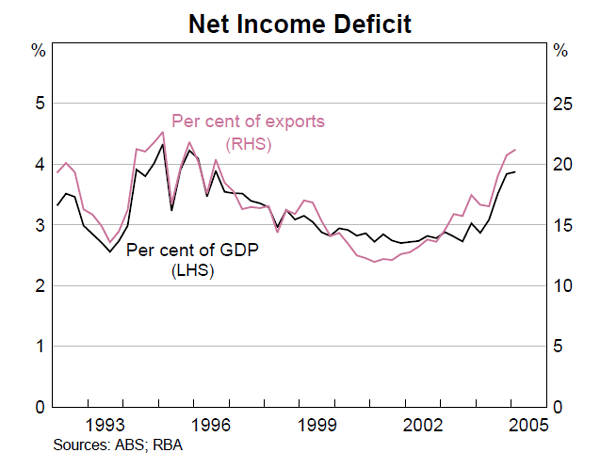
Commodity prices and the terms of trade
Buoyant global demand conditions and large increases in contract prices for Australia's iron ore and coal exports have pushed the RBA index of commodity prices (ICP) to its highest level in the 23 year history of the index. In SDR terms, the ICP is estimated to have increased by 4 per cent over the three months to July and by 24 per cent relative to its level a year earlier (Graph 40 and Table 7). In Australian dollar terms, commodity prices increased by 2½ per cent over the three months to July, to be 16 per cent higher over the year.

| Three months to July 2005 |
Year to July 2005 |
|
|---|---|---|
| RBA Index | 3.8 | 23.6 |
| Rural | 2.0 | 0.2 |
| – Wheat | 2.9 | −2.2 |
| – Beef & veal | −0.9 | 4.6 |
| – Wool | 1.4 | −2.7 |
| Base metals | −0.7 | 9.5 |
| – Aluminium | −1.9 | 6.0 |
| – Copper | 10.8 | 30.1 |
| – Nickel | −5.9 | −1.4 |
| Other resources | 5.8 | 40.3 |
| – Coking coal(a) | 59.7 | 82.3 |
| – Steaming coal(a) | 11.4 | 30.8 |
| – Iron ore(a) | 63.7 | 64.9 |
| – Gold | 2.9 | 8.3 |
| Memo item: | ||
| Oil in US$(b) | 10.8 | 44.1 |
|
(a) Period to June. Sources: ABS; AWB; AWEX; Bloomberg; Meat and Livestock Australia; RBA |
||
As noted in the May Statement, contracts for exports of iron ore and coking coal were recently negotiated with US dollar price increases of around 70 per cent and 120 per cent respectively, effective from the start of April. Over the three months to June, preliminary data suggest iron ore and coking coal prices increased by 57 and 54 per cent in US dollar terms, and these prices could rise further in the coming months. In contrast, the price increase for steaming coal exports has been more modest, following large gains last year.
The rural price index increased by 2 per cent in SDR terms over the three months to July, with wheat prices increasing over the period (Graph 41). Beef export prices fell slightly over the three months to July, although prices have picked up recently following the discovery of a second case of BSE in the US.
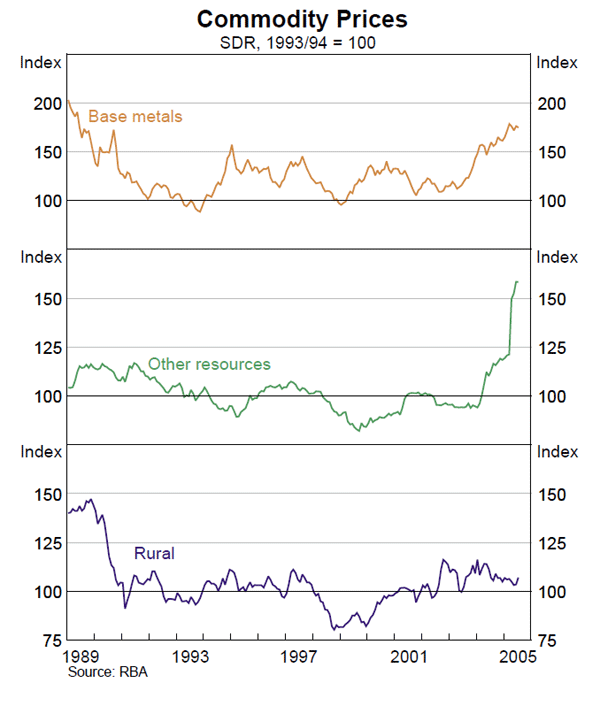
Base metals prices fell by 1 per cent in SDR terms over the three months to July, but remain at high levels. Nickel prices declined as demand for stainless steel fell back, while aluminium prices have been weighed down by strength in Chinese aluminium production. However, copper prices strengthened over the three months to July, reaching a record high in July as copper inventories held at the warehouses of the London Metal Exchange fell to thirty-year lows and strikes at various copper production facilities added to uncertainty in the market.
The terms of trade increased by 1.1 per cent in the March quarter and are estimated to have increased by around 5½ per cent in the June quarter, following the increases in iron ore and coal prices (Graph 42). This brings the total increase in the terms of trade over the past three years to around 25 per cent and their level to the highest point since 1974.
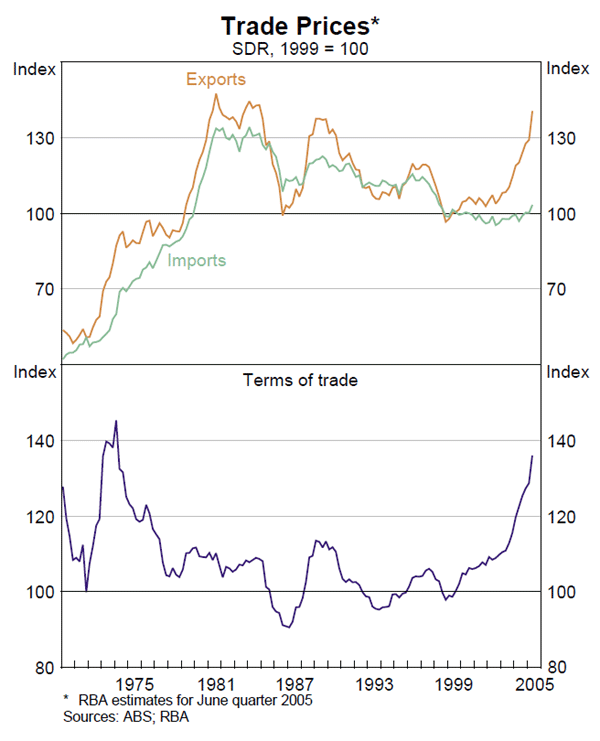
Oil prices increased over the three months to July, with the West Texas Intermediate crude oil price setting a daily record above US$61 per barrel in early August (Graph 43). The increase appeared to reflect a continuation of the shortage of excess production capacity that has weighed on the oil market for the last year. Additional recent factors include the potential for supply reductions arising from hurricanes in the Gulf of Mexico, political unrest in Nigeria and a threatened strike in Norway, as well as concerns over refining capacity constraints. The price rise occurred despite an increase in OPEC production quotas of ½ million barrels per day and higher levels of crude oil inventories in the US.
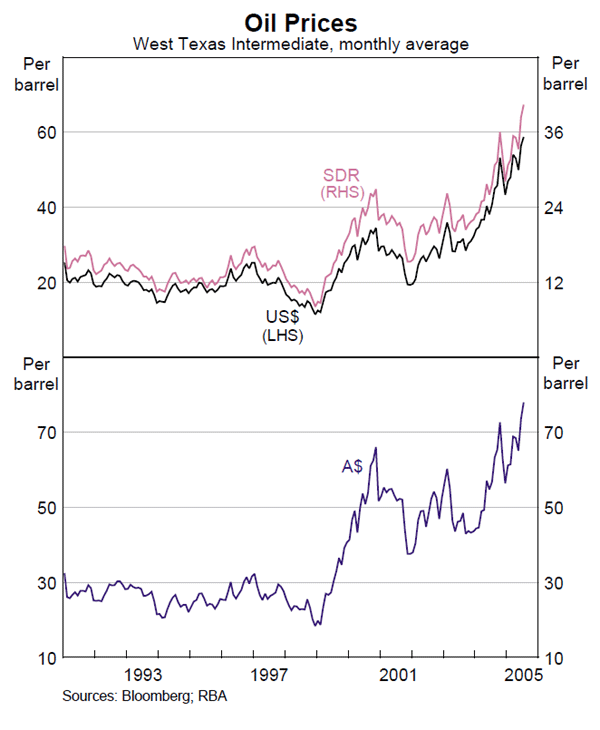
Domestic Financial Markets
Interest rates and equity prices
Money and bond yields
Short-term market rates have been fairly steady over the past few months at levels just above the cash rate target of 5½ per cent (Graph 44). This suggests there has been little change in expectations of the cash rate since the time of the previous Statement, with markets continuing to expect that monetary policy will be unchanged for the next six months or so.
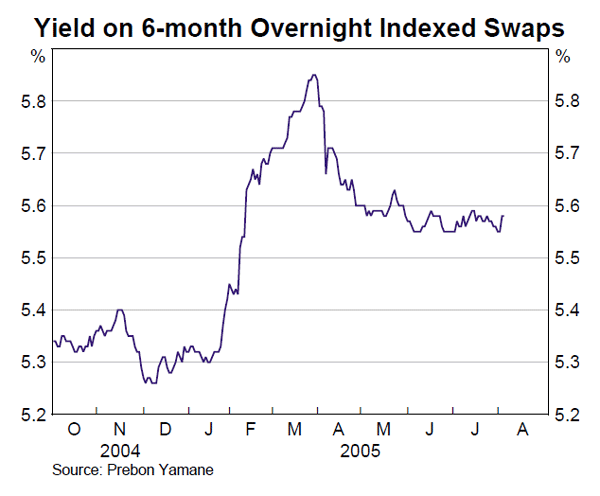
Long-term bond yields are also little changed in net terms since the previous Statement, at around 5.3 per cent. They did, however, show some variation during the period, largely in response to developments in overseas markets. Yields on 10-year government bonds rose a little in early May, before falling by around 40 basis points to 5.0 per cent by mid June. The subsequent rise in yields has been a little less than in the US, causing the spread between Australian and US 10-year bond yields to narrow to around 100 basis points.
Yields on inflation-linked bonds, at 2.6 per cent, are also unchanged in net terms since early May after falling to 2.5 per cent by mid June, their lowest recorded level (Graph 45). In contrast, indexed bond yields in the US rose over the same period.
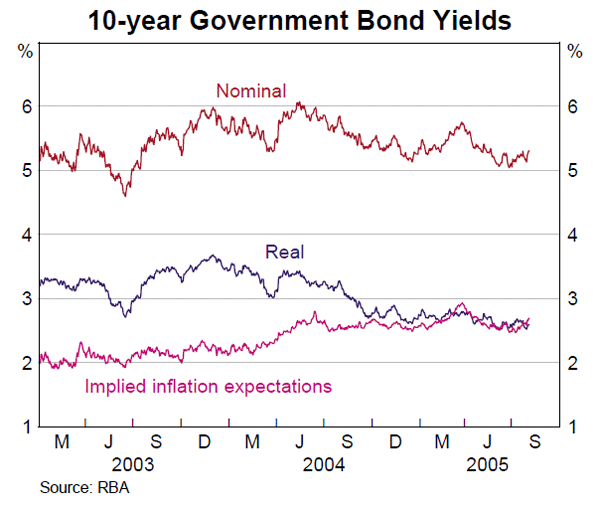
With nominal yields on government bonds around 20 basis points below the cash rate, the domestic yield curve remains inverted. An inverted yield curve normally arises when a monetary policy tightening cycle is thought to be around its peak. While the yield curve could be signalling such market expectations on this occasion, it may also be that local bond yields have been unduly influenced by the factors that have resulted in unusually low bond yields globally. As a consequence, it remains difficult to draw any firm conclusions about the expected stance of monetary policy from the shape of the yield curve at this time.
There has been little net change in the market's perceptions of corporate credit risk during the past three months. Both spreads between corporate bond yields and swap rates, and the premia on credit default swaps, remain low by historical standards (Graph 46). As with the low level of bond yields, there is a good deal of debate in global markets about whether the current levels of corporate spreads adequately reflect credit risks. Default rates on bonds have recently been low and the outlook for the corporate sector remains favourable. On the other hand, there is also evidence that spreads may have been driven down by the continued search for yield in the global, low interest rate environment.
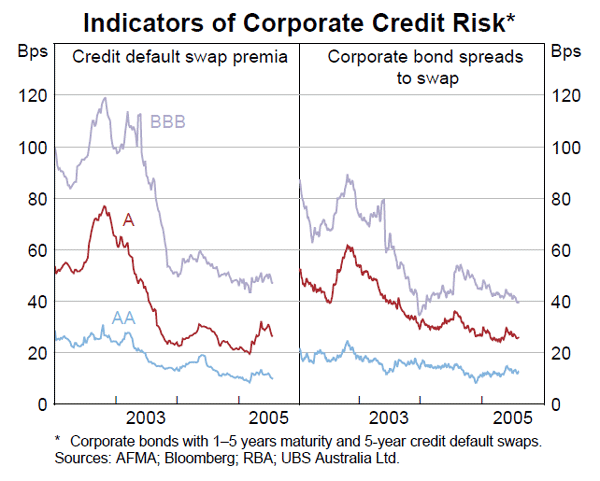
This compression of spreads has also been evident in the yields on highly-rated residential mortgage-backed securities (RMBS). From 2003 to mid 2005 the spreads at which AAA-rated tranches of RMBS were issued recorded a net fall of around 15 basis points (Graph 47). Spreads on AAA-rated corporate bonds have also declined over this period.
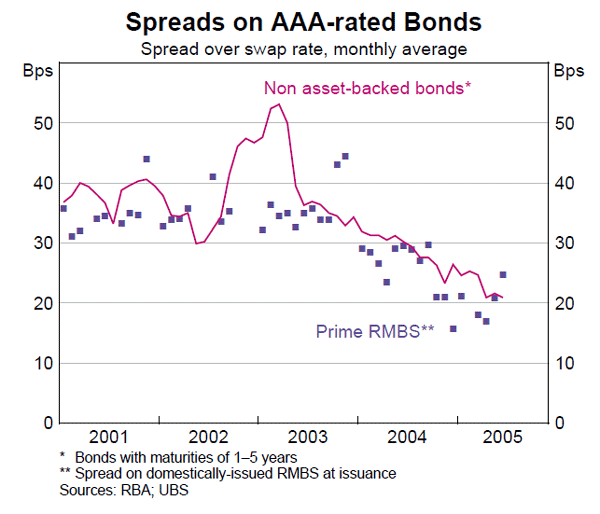
Intermediaries' interest rates
Intermediaries' variable indicator lending rates have remained broadly unchanged since the last Statement, consistent with there having been no change in the cash rate. There have, however, been some recent increases in the discounts available on some large mortgages. Interest rates on fixed-rate housing loans fell slightly, reflecting earlier reductions in the cost of funding fixed-rate loans (Graph 48 and Table 8).
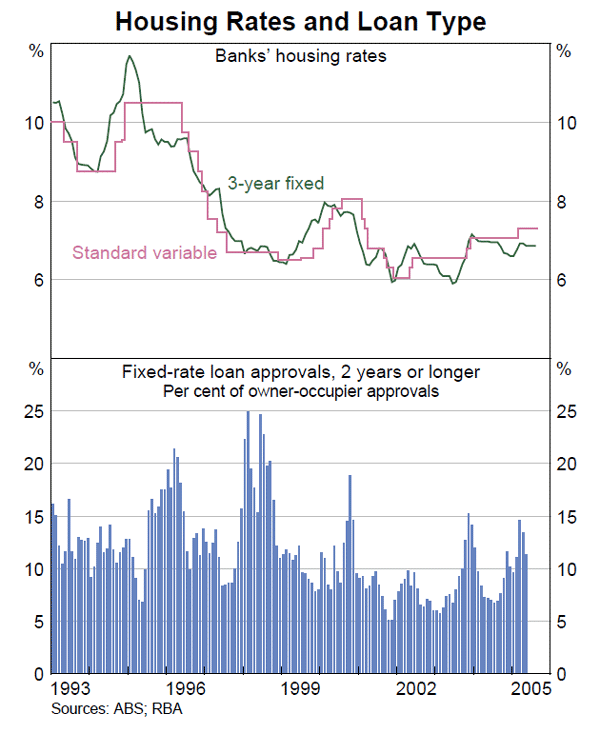
| Variable rates – household | |
|---|---|
| Housing: | |
| – Major banks' standard variable | 7.30 |
| – Major banks' basic variable | 6.75 |
| – Mortgage managers' standard variable | 6.95 |
| – Mortgage managers' basic variable | 6.35 |
| Other household: | |
| – Residential security | 7.45 |
| – Credit cards | 16.75 |
| Variable rates – small business | |
| Residential security: | |
| – Overdraft | 8.20 |
| – Term loan | 7.50 |
| Other security: | |
| – Overdraft | 9.10 |
| – Term loan | 8.10 |
| Variable rates – large business | |
| – Overdraft | 9.10 |
| Fixed rates (3 years) | |
| – Housing | 6.85 |
| – Small business | 7.30 |
| – Swap rate | 5.65 |
|
Source: RBA |
|
Demand by borrowers for fixed-rate housing loans peaked in March – probably reflecting the increase in the cash rate in that month – and has since eased, presumably as borrowers have wound back their expectations of further monetary policy tightening. In May, the latest month for which data are available, around 11 per cent of new owner-occupier housing loans were taken out at fixed rates, still a little above the average for the past five years.
Small business fixed rates, which tend to be adjusted more often than housing fixed rates, fell by around 20 basis points between April and June, but have since retraced a little, to be 10 basis points below their level as at the time of the previous Statement (Graph 49). Data on the composition of banks' outstanding business loans by type of interest rate indicate a further decline in the use of fixed-rate loans in the March quarter. Among loans with outstanding balances less than $500,000, 30 per cent were at fixed rates as at the end of March, down from around 45 per cent five years earlier, while for larger loans the fixed-rate share was below 15 per cent.

Equity prices
At the time of the previous Statement, the Australian share market had fallen to its lowest level for the year so far – around 3 per cent lower than at end December 2004. Since then, the market has more than retraced these falls, with the ASX 200 increasing by 10 per cent to reach record highs in late July. Over this period, the Australian market has performed a little more strongly than global equity markets (Graph 50).
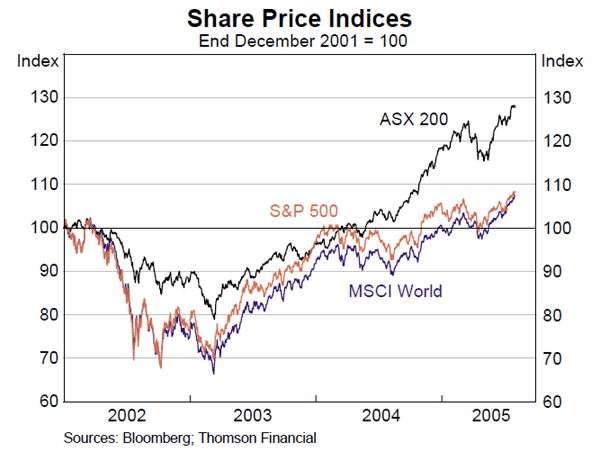
Resources companies have performed strongly over the past few months, with their share price gains driven by the strength in commodity prices and the positive outlook for global economic growth. Although the consumer discretionary sector fell sharply in the first part of the year, in response to evidence of slowing retail sales and a large number of profit warnings, it has kept pace with the market as a whole since early May (Graph 51).
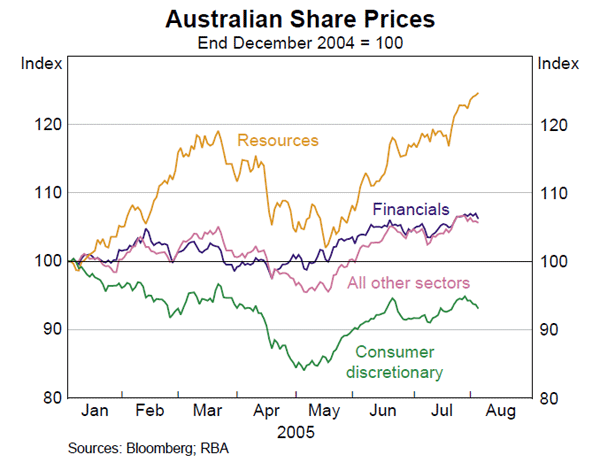
A higher-than-usual number of profit warnings have also been made by companies outside the consumer discretionary sector – mainly materials, real estate, and industrials (see Box C). However, these companies represent only a small proportion of the market and analysts' aggregate earnings expectations have been little changed in recent months (Graph 52). Ahead of the upcoming reporting season, average earnings per share for companies in the ASX 200 is expected to have increased by around 20 per cent in 2004/05, with 11 per cent growth expected in 2005/06.
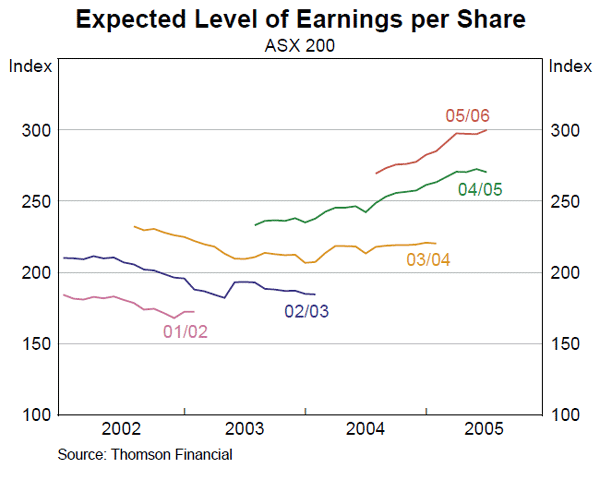
Actual earnings reported in the year to date have continued at high levels and, despite equity prices having moved noticeably higher in recent months, the price-earnings (P/E) ratio has increased only slightly. At around 16½, the ratio is a little above its long-term average. The recent price increases have also seen the dividend yield fall slightly to 3.5 per cent compared with 3.7 per cent in April (Graph 53).
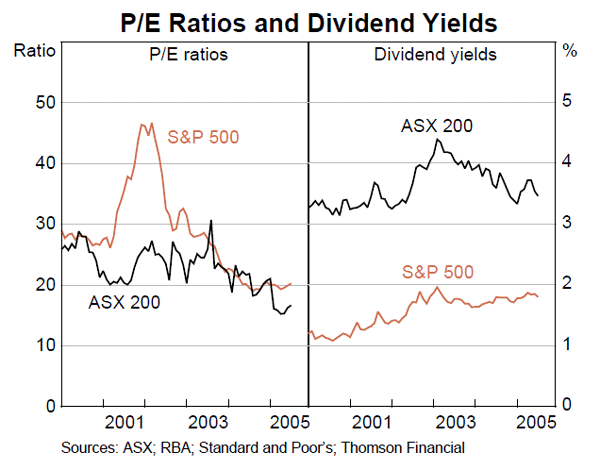
Margin lending for the purchase of shares and managed funds rose by 7 per cent in the June quarter, to $18 billion (Graph 54). Growth over the year, at 30 per cent, was the fastest since early 2002, and contributed around one-quarter of the 14 per cent growth in total personal credit over this period. The growth in margin debt over the year was due to a rise in the number of borrowers and an increase in the average size of outstanding loans, which rose by around 18 per cent, to $118,000. As is typical in the June quarter, a higher proportion, 60 per cent, of new loans was taken out at fixed rates with interest pre-paid, thereby enabling investors to bring forward tax deductions.
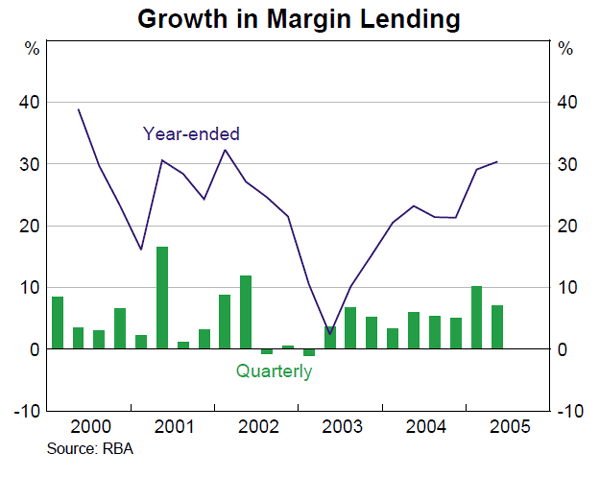
Despite the recent strong growth, indicators of the riskiness of investors' margin loan positions, such as average leverage and the percentage of credit limits used, remain low. Reflecting this and general strength in the share market, the average frequency of margin calls was also low.
Financing activity
Debt markets
Australian non-government entities issued a record $50 billion of bonds in the June quarter (Table 9 and Graph 55). The strength in issuance was broad-based; gross issuance in both the domestic and offshore markets was 70 per cent higher than the respective post-2001 quarterly averages, with non-financial corporates, financial institutions and asset-backed vehicles all recording above-average issuance.
| 2002 | 2003 | 2004 | 2005 | ||
|---|---|---|---|---|---|
| March quarter |
June quarter |
||||
| Bond issues by Australian entities | |||||
| Onshore | |||||
| Financial institutions | 7.4 | 9.8 | 14.0 | 6.1 | 3.7 |
| Non-financial corporates | 7.6 | 4.9 | 8.0 | 1.1 | 2.4 |
| Asset-backed | 19.3 | 21.2 | 25.0 | 8.6 | 10.4 |
| Total | 34.3 | 35.9 | 47.0 | 15.8 | 16.5 |
| Offshore | |||||
| Financial institutions | 32.2 | 49.8 | 63.9 | 14.8 | 16.8 |
| Non-financial corporates | 10.5 | 14.7 | 14.3 | 2.2 | 8.6 |
| Asset-backed | 16.6 | 24.3 | 29.8 | 7.1 | 7.7 |
| Total | 59.3 | 88.8 | 108.0 | 24.1 | 33.1 |
| Total | 93.6 | 124.7 | 155.0 | 39.9 | 49.6 |
| A$ bond issues by non-resident entities | |||||
| Onshore | 3.1 | 7.1 | 21.3 | 6.1 | 3.4 |
| Offshore | 17.4 | 24.4 | 21.5 | 4.8 | 2.9 |
| Total | 20.5 | 31.5 | 42.8 | 10.9 | 6.3 |
|
Source: RBA |
|||||
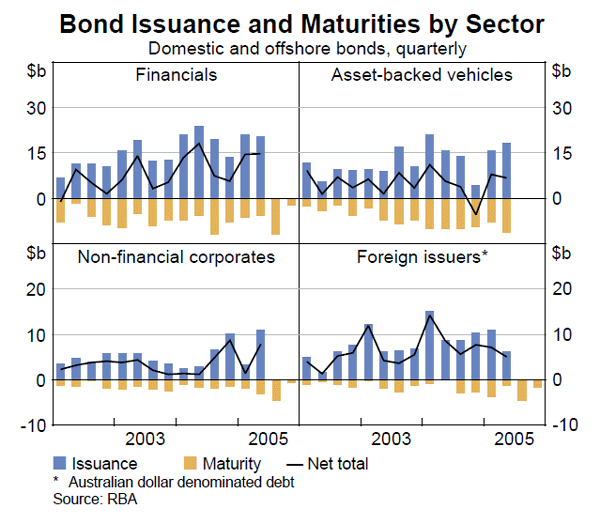
Around four-fifths of non-financial corporates' issuance was into offshore markets, mostly the US private placement market. The funds appear to have been mainly used to refinance existing bank debt and maturing corporate bonds. A larger-than-usual proportion of issuance by asset-backed vehicles was into the domestic market (though foreign interest in these securities remained strong). In contrast, financial institutions continued to heavily favour offshore markets when issuing bonds in their own name.
There have been few announcements of new hybrid securities since the previous Statement. Contributing to this is the fact that many banks are close to their Tier 1 limits for hybrid capital. Issuance by non-financial corporates was quite strong in the early part of the year.
Equity raisings
Net equity raisings in the June quarter were around their post-2001 quarterly average (Graph 56). IPO activity was strong, with 49 companies raising a total of $2.5 billion. Companies in the financials sector – mostly listed investment funds and property trusts – accounted for 70 per cent of the value of IPO capital raised. Other equity raisings were a little below average and there was also a somewhat higher-than-usual amount of buybacks in the quarter. Non-financial corporates accounted for almost all of the buybacks, led by large off-market buybacks by Rio Tinto and Coles Myer.
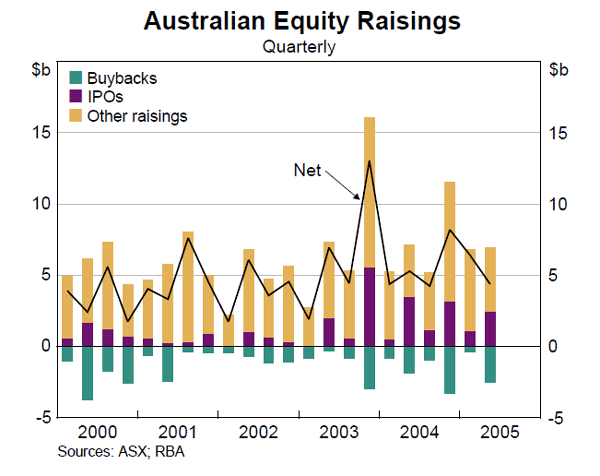
Box C: Recent Corporate Profit Warnings
As discussed in the May Statement,[1] profits of listed companies have increased strongly in recent years. Profit growth was particularly strong in the first half of 2004/05, with listed companies' aggregate underlying profits being 33 per cent higher than in the corresponding period of the previous year. This compares with average annual growth in underlying profits of 11 per cent since 1997.
In the first six months of 2005, 130 listed companies issued warnings that profits in 2004/05 as a whole would most likely be less than previously expected. (There have also been a few warnings made since then.) This is around 8 per cent of all companies listed on the Australian Stock Exchange, a share which is quite high by recent historical standards (top panel of Graph C1). Part of the increase in the number of companies issuing warnings is probably a result of increased pressure to improve transparency and provide fairly explicit earnings forecasts to the general public. It is also perhaps an attempt by companies to rein in expectations of a continuation of the recent very strong pace of profit growth. Moreover, the companies that have issued profit warnings tend to have been small. As a result, they comprise around 7 per cent of total market capitalisation, which is not high by recent historical standards (bottom panel of Graph C1).
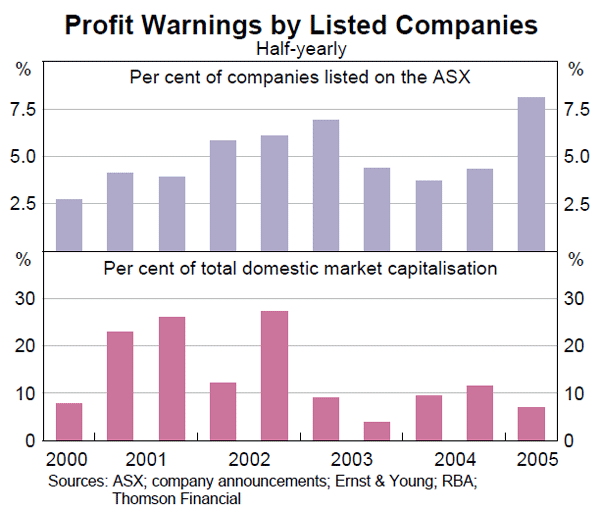
Of companies giving warnings, 59 per cent cited factors which could be considered company-specific (such as write-offs of capital expenditure, restructuring costs, staff redundancies, the loss of a major customer or contract to a competitor, and interruptions in production or distribution) (Table C1). The next most commonly cited reason was difficult trading conditions, in some cases driven by weaker residential construction activity.
| Reason | |
|---|---|
| Company-specific issues | 59 |
| Tougher trading conditions | 44 |
| of which related to weaker residential construction | 9 |
| Adverse currency movements | 16 |
| Higher cost of raw materials | 14 |
| Weather conditions | 8 |
| Higher fuel costs | 8 |
| Labour shortages/higher wages | 5 |
|
(a) Some companies cited multiple reasons. Sources: company announcements; RBA |
|
Of companies issuing warnings for the 2004/05 financial year, almost two thirds by number (79 out of 130) and 40 per cent by market capitalisation expect negative earnings growth – that is, a lower level of earnings (Table C2). The remaining companies are expecting positive, but lower-than-initially forecast, growth in earnings in 2004/05. Many of these will probably still report strong earnings growth, with aggregate earnings for these companies expected to be almost 23 per cent higher than in 2003/04, virtually the same as the growth rate for the broader market. This suggests many of the profit warnings were merely a scaling back of extremely strong expectations.
| Earnings(a) | ||||
|---|---|---|---|---|
| Number of companies |
Per cent of market capitalisation(b) |
Full year 2004/05 $b |
Growth since 2003/04 Per cent |
|
| Companies issuing warnings in January–June 2005: |
||||
| Negative earnings growth | 79 | 2.6 | 1.51 | −28 |
| Lower earnings growth | 51 | 4.3 | 2.30 | 23 |
| ASX 200 | 200 | 82.5 | 47.95 | 22 |
|
(a) Includes companies that made losses in either financial year. Excludes
companies that did not provide quantitative guidance. Sources: ASX; company announcements; Ernst & Young; RBA; Thomson Financial |
||||
As noted above, the profit downgrades were concentrated amongst companies that tended to be a bit smaller than average. As well, some companies have indicated that profits will be stronger than previously expected. Reflecting this, forecasts for growth in aggregate earnings in 2004/05 have been revised down only slightly in the last couple of months, to around 22 per cent for companies in the ASX 200. Growth in 2005/06 is expected to be around 15 per cent.
Financial Conditions
Financial conditions are at present reasonably accommodative. The overnight cash rate remains close to its average level of the past decade in both real and nominal terms, and advertised indicator interest rates for housing and business lending are also close to average levels. The cash rate is at present slightly above longer-term bond yields, which is often considered to be a sign that the market views current policy settings as relatively tight. However, as has been the case for some time now, Australian bond yields are to a large extent being influenced by unusually low US bond yields, which themselves are at odds with rising short-term interest rates and data suggesting solid growth in the US economy.
Policy may in fact be more accommodative than would be suggested by some of these standard benchmarks. Although indicator interest rates on business lending are near historical average levels, broader measures of the actual cost of borrowing, which incorporate margins and discounts, remain low. Similarly, the increased tendency for lenders to offer discounts means that actual interest rates paid on new housing loans are lower than the cash rate suggests (Graph 57). Although up-to-date figures on the extent of home-loan rate discounting are not available, there is evidence suggesting that the size and availability of these discounts have increased of late. The recent upswing in refinancing activity also implies that a greater proportion of all mortgage borrowers are taking advantage of these discount offers.

Credit continues to grow faster than nominal income, suggesting that interest rates are not overly constraining demand for credit. Total credit increased at an annualised rate of 11½ per cent over the six months to June (Table 10, Graph 58). The annualised growth of business credit was 12½ per cent over the same period, continuing the upward trend that has been evident over the past few years. Coupled with the persistent strength in capital market raisings, this suggests that businesses' access to external finance remains unimpeded. In contrast, the six-month-ended annualised rate of household credit growth continued its downward trend that began in late 2003, reaching 10¾ per cent in June. The downward trend in household credit growth largely reflects developments in housing credit. Growth in the smaller non-housing personal component has also moderated from its recent peak in January 2005, to an annualised rate of 10½ per cent over the six months to June. This is consistent with the decline in personal loan approvals, and mainly reflects falls in fixed-term lending, though the revolving component has also contributed.
| Six-month-ended annualised | ||||
|---|---|---|---|---|
| June 2004 | December 2004 | June 2005 | Year-ended June 2005 |
|
| Total credit | 12.7 | 12.2 | 11.4 | 11.8 |
| Household | 16.4 | 13.2 | 10.8 | 12.0 |
| – Housing | 17.2 | 12.3 | 10.9 | 11.6 |
| – Personal | 12.3 | 18.2 | 10.4 | 14.2 |
| Business | 6.6 | 10.5 | 12.5 | 11.5 |
| Broad money | 7.8 | 9.9 | 11.3 | 10.6 |
|
Source: RBA |
||||
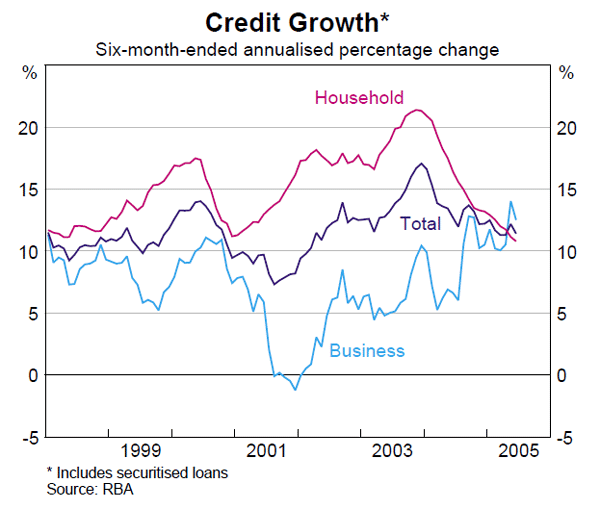
The Australian dollar is around 13 per cent above its post-float average, measured in quarterly average real trade-weighted terms. While the relatively high real exchange rate is likely to be constraining activity for some exporting and import-competing firms, the current level of the exchange rate is lower than might have been suggested by its past relationship with the terms of trade (Graph 59).

Inflation Trends and Prospects
Recent developments in inflation
The Consumer Price Index (CPI) rose by 0.6 per cent in the June quarter, to be 2.5 per cent higher over the year (Graph 60, Table 11). Petrol prices made the most significant contribution to the overall increase in both quarterly and year-ended terms; they increased by over 7 per cent in the quarter and by 10½ per cent over the year, reflecting movements in world oil prices. Other significant contributions to CPI inflation in the June quarter were made by hospital and medical services prices, largely due to the increase in health insurance premiums, and house purchase costs. The cost of domestic holiday travel and accommodation declined in the quarter, in part reflecting unusually high prices in the March quarter associated with the early timing of Easter; fruit prices also fell significantly.
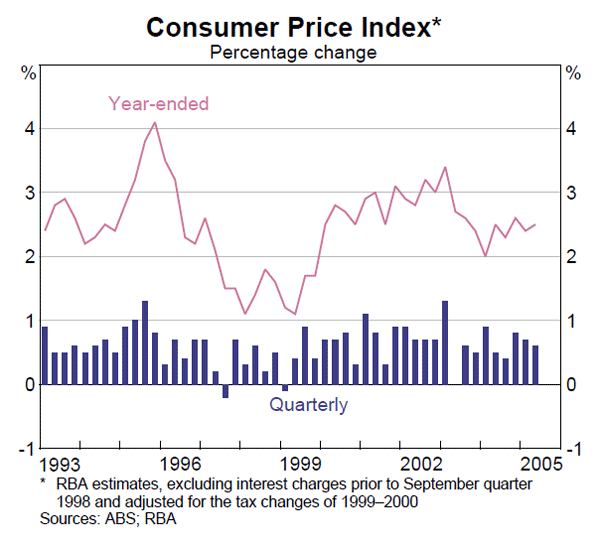
| Quarterly | Year-ended | ||||
|---|---|---|---|---|---|
| March quarter 2005 |
June quarter 2005 |
March quarter 2005 |
June quarter 2005 |
||
| CPI | 0.7 | 0.6 | 2.4 | 2.5 | |
| – Tradables | −0.1 | 0.8 | 0.6 | 1.3 | |
| – Tradables (ex food and petrol) | −0.1 | 0.3 | −0.2 | −0.1 | |
| – Non-tradables | 1.3 | 0.5 | 3.7 | 3.5 | |
| Underlying measures | |||||
| Weighted median | |||||
| – Seasonally adjusted distribution(a) | 0.5 | 0.7 | 2.4 | 2.5 | |
| – Unadjusted distribution | 0.5 | 0.7 | 2.2 | 2.4 | |
| Trimmed mean | |||||
| – Seasonally adjusted distribution(a) | 0.5 | 0.7 | 2.6 | 2.6 | |
| – Unadjusted distribution | 0.5 | 0.6 | 2.3 | 2.4 | |
| CPI ex petrol | 0.8 | 0.3 | 2.0 | 2.1 | |
| CPI ex volatile items(b) | 0.8 | 0.4 | 2.4 | 2.3 | |
|
(a) Based on the distribution of seasonally adjusted quarterly price changes. Sources: ABS; RBA |
|||||
The Bank's assessment is that underlying inflation was also around 2½ per cent over the year to the June quarter, based on a range of indicators including statistical measures of inflation calculated from the seasonally adjusted price distribution (for more detail, see ‘Box D: Measures of Underlying Inflation’ and Table 11).
The gap between tradables and non-tradables price inflation has continued to narrow (Graph 61). Tradables prices increased by 1.3 per cent over the year to the June quarter, although they were broadly flat excluding food and petrol prices. The dampening impact on tradables prices of the appreciation of the exchange rate over 2002 and 2003 appears to have largely passed. Non-tradables price inflation remained firm at 3.5 per cent over the year, but its pace has continued to ease. This partly reflects developments in house purchase costs, which have a large weight in the index. While house purchase costs increased by 5 per cent over the year, the pace of growth has moderated since the peak of over 6 per cent in late 2003, in line with developments in dwelling construction activity.
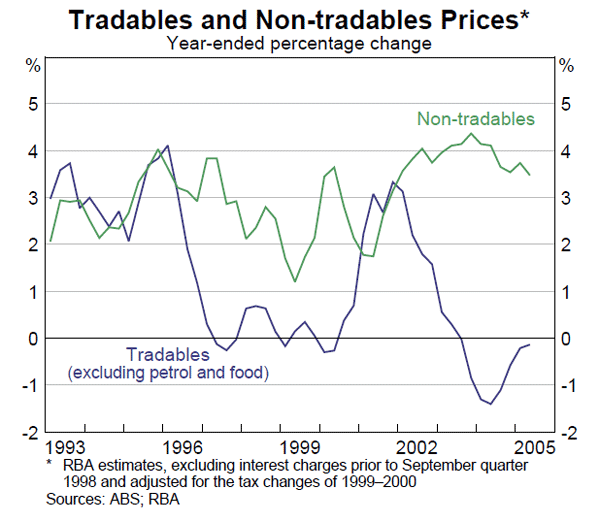
Producer prices
Producer price data indicate that price increases in the first half of 2005 were more moderate than those seen in the second half of 2004, particularly at the final stage of production (Graph 62, Table 12). The significant increase in world oil prices in the June quarter dominated the movements in producer prices in that quarter, accounting for roughly half of the quarterly price increase at each stage of production.
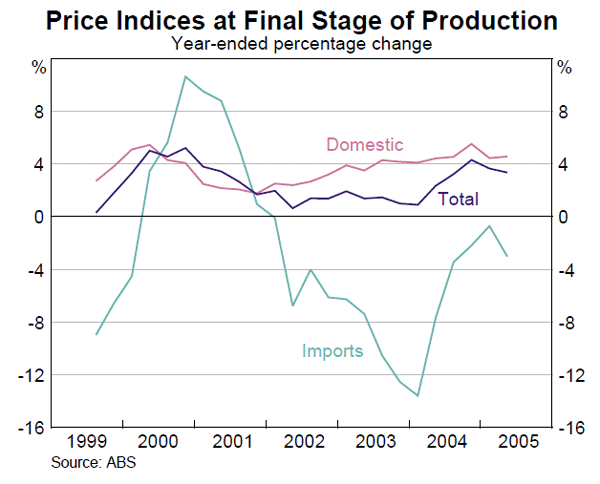
| June quarter 2005 |
Year to June quarter 2005 |
Second half 2004(a) |
First half 2005(a) |
|
|---|---|---|---|---|
| Preliminary | 2.3 | 6.0 | 8.9 | 3.2 |
| – Domestically produced | 1.6 | 5.2 | 8.2 | 2.3 |
| – Imported | 6.7 | 10.0 | 12.1 | 8.0 |
| – Excluding oil | 1.0 | 4.2 | 6.0 | 2.4 |
| Intermediate | 1.7 | 4.7 | 7.0 | 2.4 |
| – Domestically produced | 1.4 | 4.7 | 7.0 | 2.3 |
| – Imported | 3.9 | 4.8 | 6.4 | 3.3 |
| – Excluding oil | 0.9 | 3.5 | 5.1 | 1.9 |
| Final(b) | 0.8 | 3.4 | 5.2 | 1.6 |
| – Domestically produced | 1.0 | 4.6 | 6.4 | 2.8 |
| – Imported | −0.1 | −3.0 | −1.4 | −4.6 |
| – Excluding oil | 0.4 | 3.0 | 4.7 | 1.3 |
|
(a) Annualised Source: ABS |
||||
Prices at the final stage of production increased by 0.8 per cent in the June quarter, to be 3.4 per cent higher over the year. Abstracting from the direct effects of oil, the prices of domestically produced final goods increased by 0.6 per cent in the quarter, primarily due to a 1.1 per cent increase in building construction prices. Although still large, the increase in construction prices was the smallest seen for several years, suggesting that price pressures in the construction industry are moderating. The prices of final imported goods fell marginally in the June quarter, due to falls in the prices of capital goods such as electronic equipment and motor vehicles & parts.
Labour costs
Most measures of aggregate wage growth showed some pick-up in wage pressures in the March quarter, and there was tentative evidence that these pressures were more broadly based than in previous quarters. These outcomes are consistent with the strong labour market developments in 2004 and the first half of 2005, and with information obtained through the Bank's liaison program.
The wage price index (WPI) grew by 1.1 per cent in the March quarter, to be 3.9 per cent higher over the year (Graph 63). The average annualised wage increase (AAWI) for federal enterprise bargaining agreements certified in the March quarter was 4.3 per cent, while the AAWI for federal agreements current in the quarter was unchanged at 4.0 per cent. Other official labour cost data based on wage bills, such as average weekly ordinary-time earnings and average earnings from the national accounts, also showed that wage growth strengthened in the March quarter. In contrast, the NAB quarterly business survey reported that year-ended growth in actual labour costs was steady in the June quarter.
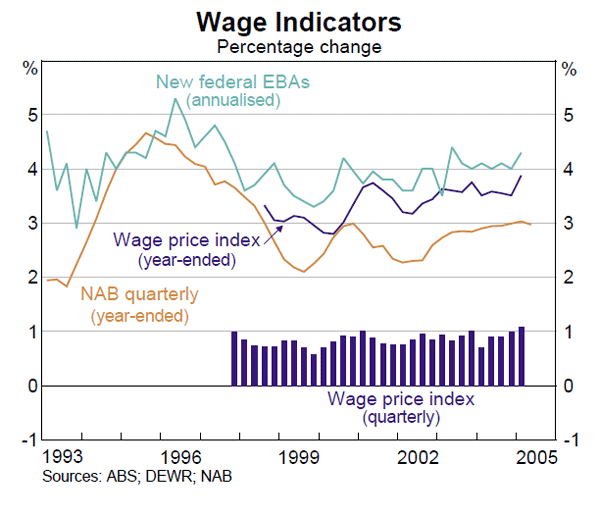
Official wage statistics and liaison contacts suggest that recent wage pressures have been concentrated in certain sectors. The WPI indicated that firm wage growth continued in education and in industries facing strong demand, such as construction and mining, and feedback from the Bank's liaison program shows large wage pressures in non-residential construction and business services. Furthermore, there was also some evidence that these pressures have broadened to other sectors, with the WPI recording a pick-up in wage growth in a number of other industries.
Business surveys continue to suggest that firms have been experiencing difficulty finding suitable labour, though this situation has eased a little recently (Graph 64). Liaison contacts report that forms of non-wage remuneration, such as bonus payments, larger employer superannuation contributions, earlier promotions and more flexible working arrangements, have been increasingly used to attract and retain staff in recent months. Staff training costs are also reported to have increased.
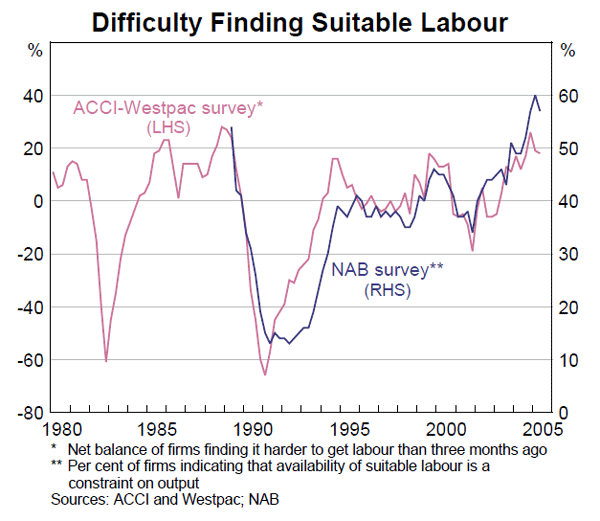
Unit labour costs, which measure total labour costs per unit of output, grew by 1.6 per cent in the March quarter to be 4.1 per cent higher over the year, which is above the average pace of growth of the past five years. The growth in unit labour costs mostly reflects a reported slowing in labour productivity, as output growth eased at the same time as employment growth was strong. Looking ahead, the effects of the increased unit labour costs on CPI inflation will depend on whether firms absorb these costs or pass them on to consumers.
Inflation expectations
Business surveys generally suggest near-term inflationary pressures are contained. In the ACCI-Westpac June quarter survey, the net balance of manufacturing firms expecting to raise prices over the coming months remained at a low level. The NAB survey reported that, while inflation in final prices across all industries is expected to increase in the September quarter, retail price inflation is expected to remain steady.
Private-sector expectations for year-ended CPI inflation over the next two years are contained in a relatively narrow range between 2½ and 3 per cent. Both market economists and union officials, surveyed after the release of the June quarter CPI, expect inflation to pick up over the year to June 2006; the median expectation of both groups is 2¾ per cent (Table 13). Thereafter, the median expectation of market economists is for CPI inflation to ease back to 2½ per cent over the year to June 2007. The median expectation for union officials is for year-ended inflation to rise to 3 per cent by the end of 2006 and to then stabilise around this level. Consumers' expectations of inflation over the year ahead, as reported in the Melbourne Institute survey, stand at 4.7 per cent. While slightly higher than its average over the past five years, this series has shown little correlation with either current or future inflation in recent years. Finally, financial market participants' medium-term inflation expectations, calculated as the difference between nominal and indexed bond yields, have remained broadly steady since the last Statement, averaging 2.6 per cent over the past three months.
| Year to June 2006 | Year to June 2007 |
||||
|---|---|---|---|---|---|
| February 2005 |
May 2005 |
August 2005 |
August 2005 |
||
| Market economists(a) | 2.6 | 2.6 | 2.7 | 2.5 | |
| Union officials(b) | 3.0 | 2.8 | 2.8 | 3.0 | |
| (a) RBA survey (b) ACIRRT survey |
|||||
Inflation outlook
CPI inflation was 2.5 per cent over the year to the June quarter and, based on a range of indicators, the Bank's assessment is that underlying inflation was running at a similar rate. Quarterly inflation outcomes have been relatively stable recently, with a modest slowing in inflation of non-tradables roughly offset by the gradual pick-up in tradables inflation. Looking forward, it is likely that the dampening effect of the 2002 and 2003 exchange rate appreciation on tradables inflation has mostly passed, and recent wage outcomes have been firm. At the same time, the slowing in the pace of domestic demand growth should contain overall price pressures. These developments suggest that underlying inflation is evolving as foreshadowed in the May Statement on Monetary Policy, with underlying inflation still expected to increase gradually, reaching 3 per cent in the second half of 2006. However, based on the easing of demand growth apparent so far this year, this is likely to be the peak, with underlying inflation not expected to increase beyond 3 per cent in 2007. In the near term, headline CPI inflation is likely to be above underlying inflation reflecting the pass-through of the current strength in oil prices, which are assumed to remain broadly unchanged over the forecast horizon.
The risks to the projection of underlying inflation appear to be balanced. On the one hand, if the current strength of the labour market were to persist, there is an upside risk that labour cost growth could pick up faster than is currently assumed. In addition, oil prices have increased significantly recently and are expected to remain at high levels, which could lead to second-round price effects and an upward adjustment in inflation expectations. On the other hand, the slower pace of domestic demand compared with last year's rate has increased the likelihood that further upstream price pressures, should they eventuate, will be absorbed into profit margins rather than be passed on to final consumer prices.
Box D: Measures of Underlying Inflation
Australia's inflation target is expressed in terms of the Consumer Price Index (CPI). With inflation low and relatively stable, CPI inflation has been a reasonable guide to trend inflationary pressures in recent years. However, the CPI is still subject to a degree of short-term volatility, which sometimes makes it difficult to interpret quarterly movements in measured inflation. Accordingly, the Bank continues to incorporate a selection of underlying inflation measures, which are less affected by short-term volatility, into its analysis of the economy. These include exclusion-based measures (such as the CPI excluding volatile items) and statistical measures (such as the trimmed mean and weighted median).[1] Recent research has shown that, while existing statistical measures perform satisfactorily as measures of underlying inflation, they can be enhanced, at the margin, by technical modifications to better account for seasonality, as outlined in Roberts (2005). This Box introduces four underlying inflation measures that have been modified along these lines, and explains how they augment the existing set of underlying inflation measures published by the Bank.
The trimmed mean and weighted median measures published by the Bank have been calculated each quarter using disaggregated quarterly price changes and expenditure weights drawn from the CPI. Year-ended rates have then been calculated by compounding the quarterly movements. There are a couple of alternatives to this approach that provide slightly different estimates of underlying inflation when CPI components display seasonality in the timing of their price changes. One is to calculate the quarterly trimmed mean and weighted median inflation rates using seasonally adjusted quarterly price changes; another is to calculate year-ended underlying rates directly using year-ended price changes.
To understand the issues raised by seasonality at the CPI component level, it is helpful to consider the example of the trimmed mean. The trimmed mean is calculated as the weighted mean of the central 70 per cent of the distribution of quarterly price changes when the latter are arranged in order of magnitude. Goods and services in the CPI that display seasonally large increases once a year often fall into the top 15 per cent of the distribution in the quarters when these large price changes occur, and are therefore removed in those quarters. However, it is much less likely that they would fall into the lower 15 per cent of the distribution in the quarters when they tend to have only small price changes. The tendency to trim high outcomes but not low ones will result, on average, in a slightly lower inflation rate for statistical measures such as the trimmed mean than for the published CPI.
Seasonally adjusting prices at the disaggregated component level can eliminate bias from such effects by smoothing seasonal increases over the course of a year. Calculating the trimmed mean directly on an annual basis achieves a similar effect, because large seasonal quarterly movements in particular components tend to wash out of year-ended price changes. Both approaches reduce the chance that a strong seasonal price movement will regularly be trimmed from the distribution of price changes. For example, the pharmaceuticals component is one of the items most frequently removed by the trimmed mean based on unadjusted quarterly price changes, owing to a large positive movement once each year resulting from the operation of the Pharmaceutical Benefits Scheme. But when prices are seasonally adjusted, or annual price changes are used, this component is removed far less frequently.
Graph D1 shows the trimmed mean and weighted median based on unadjusted quarterly price changes, seasonally adjusted quarterly price changes and year-ended price changes. It is apparent that the different measures are highly correlated, but the measures based on seasonally adjusted quarterly price changes and year-ended price changes tend to be slightly higher than the unadjusted measures. Over time, on average, the unadjusted measures record slightly lower inflation than the CPI. By comparison, there is no evidence that growth in the four alternative underlying inflation measures is substantially different on average from CPI inflation.
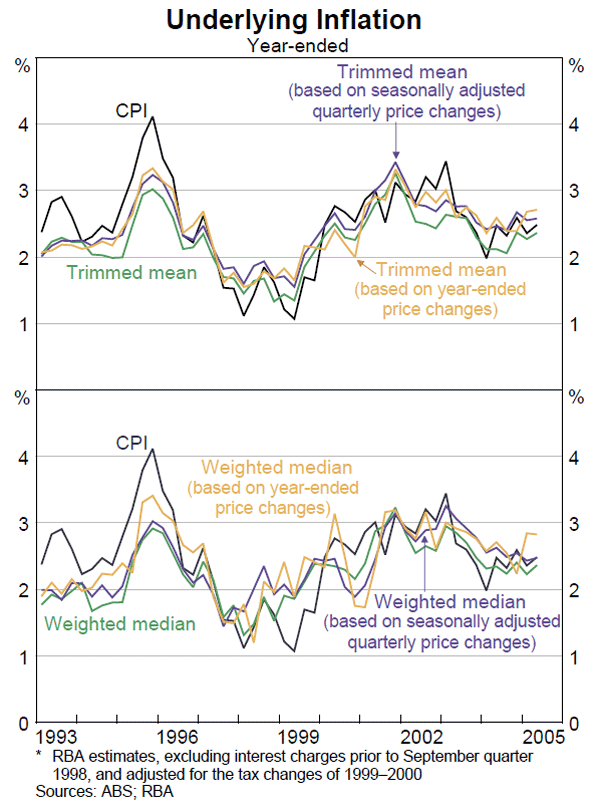
All of the statistical underlying inflation measures considered in this Box have been found in recent research to perform satisfactorily, on various criteria, as measures of underlying inflation. The fact that the measures based on seasonally adjusted or annual price changes have been unbiased with respect to CPI inflation suggests that they may be conceptually superior as measures of underlying inflation. In practice, however, the calculation of these types of measures is complicated by the need to seasonally adjust data, which involves potential revisions to the series as estimates of seasonality are updated. Furthermore, there is the added complication of periodic compositional change, following the five-yearly revisions to the CPI basket. Accordingly, it is likely that both the traditional and the new measures will be useful in making ongoing assessments of inflationary pressures.
Footnotes Box B
See the article on ‘Measuring Housing Prices’ in the RBA Bulletin, July 2004, for a more detailed discussion. [1]
However, the ABS has indicated that its new house price measure, expected to be released later this year, will use data from bank loan applications and possibly some from state Real Estate Institutes for preliminary contract-dated price indices. [2]
For example, the series from APM, CBA, and REIA. The exceptions are Residex, which uses repeat sales analysis, and the ABS which adjusts for compositional change by stratifying sales by geographic region. [3]
However, there is cross-country evidence that ratios of house prices to labour income tend to be higher in larger cities: see the article on ‘City Sizes, House Prices and Wealth’ in the RBA Bulletin, December 2001. [4]
Footnote Box C
See ‘Box D: December Half 2004 Profit Results’, Statement on Monetary Policy, May 2OO5, pp 54–55. [1]
Footnotes Box D
The advantages and disadvantages of both types of measures have been explored in detail in recent Bank publications. For more information, see: ‘Box D: Underlying Inflation’, Statement on Monetary Policy, May 2002, pp 55–56; Heath, Roberts and Bulman (2004), ‘Inflation in Australia: Measurement and Modelling’, in Kent and Guttmann (eds), The Future of Inflation Targeting, Proceedings of a Conference, Reserve Bank of Australia, pp 167–207; and Roberts (2005), ‘Underlying Inflation: Concepts, Measurement and Performance’, Reserve Bank of Australia Research Discussion Paper No 2005-05. [1]